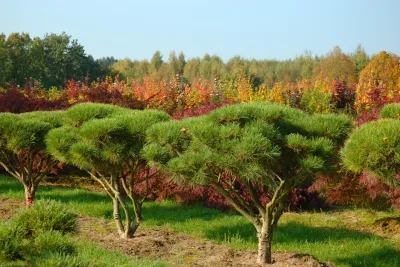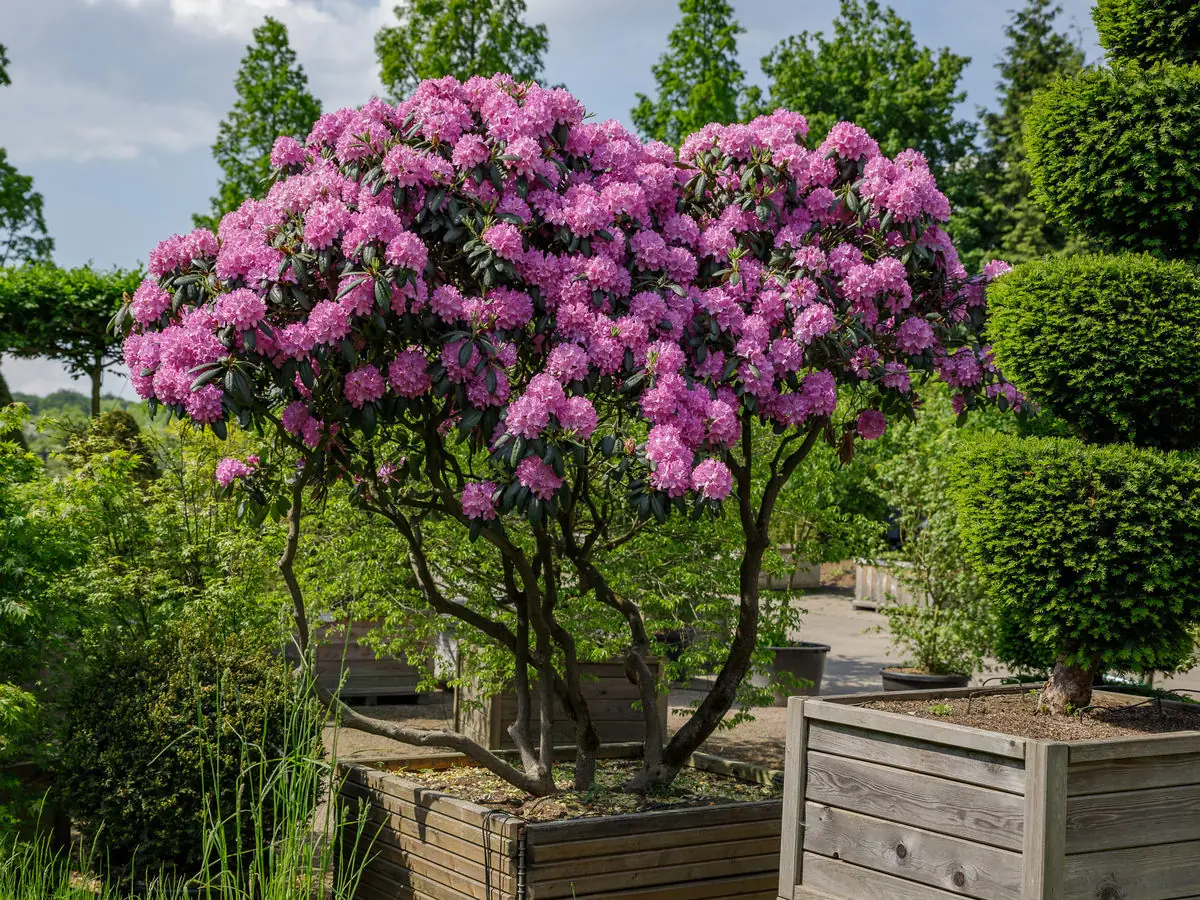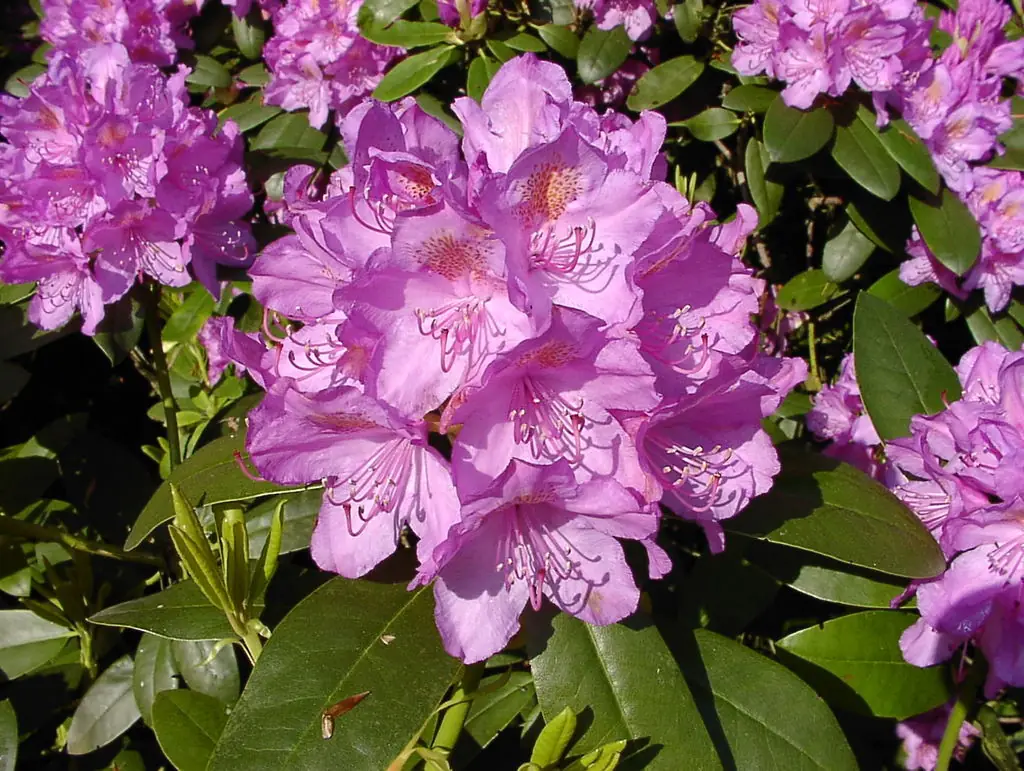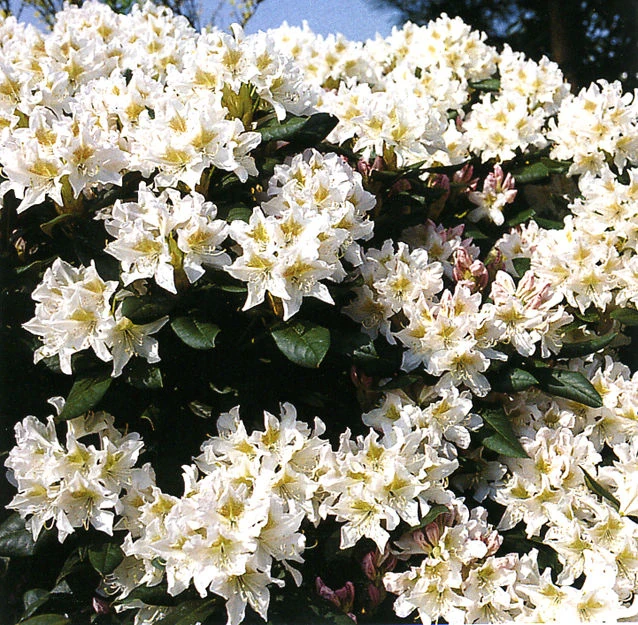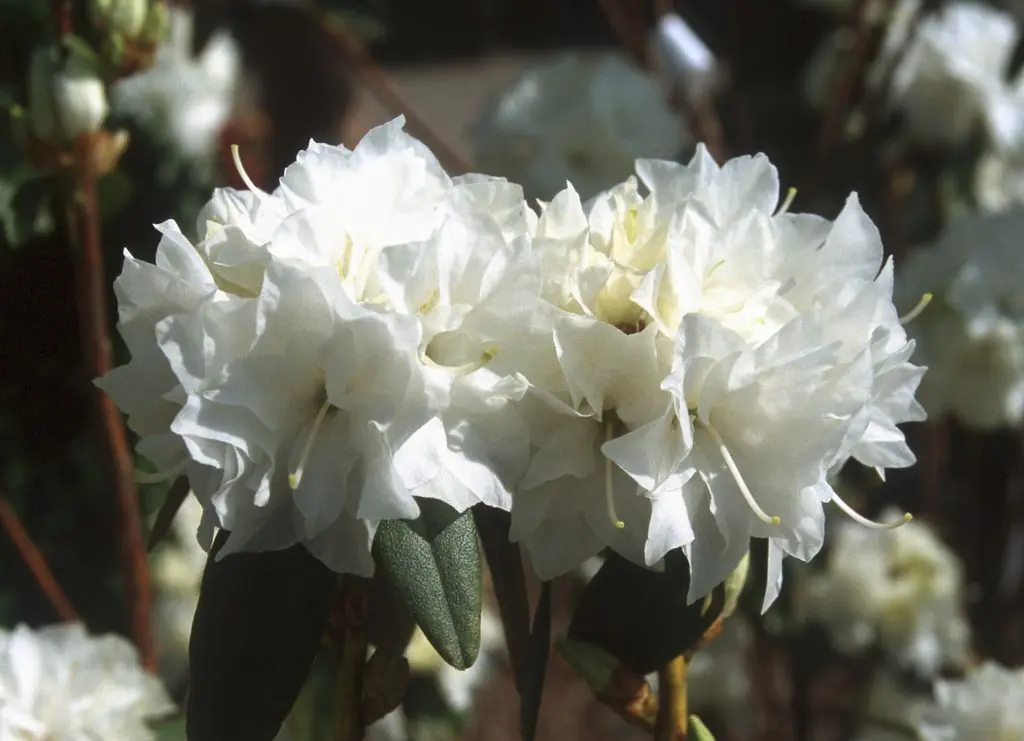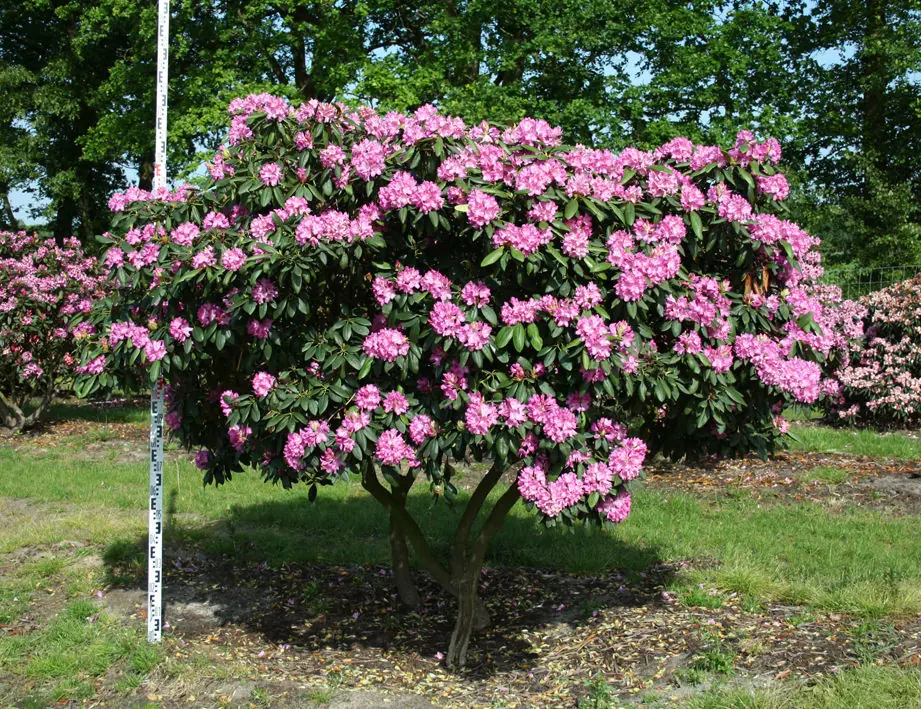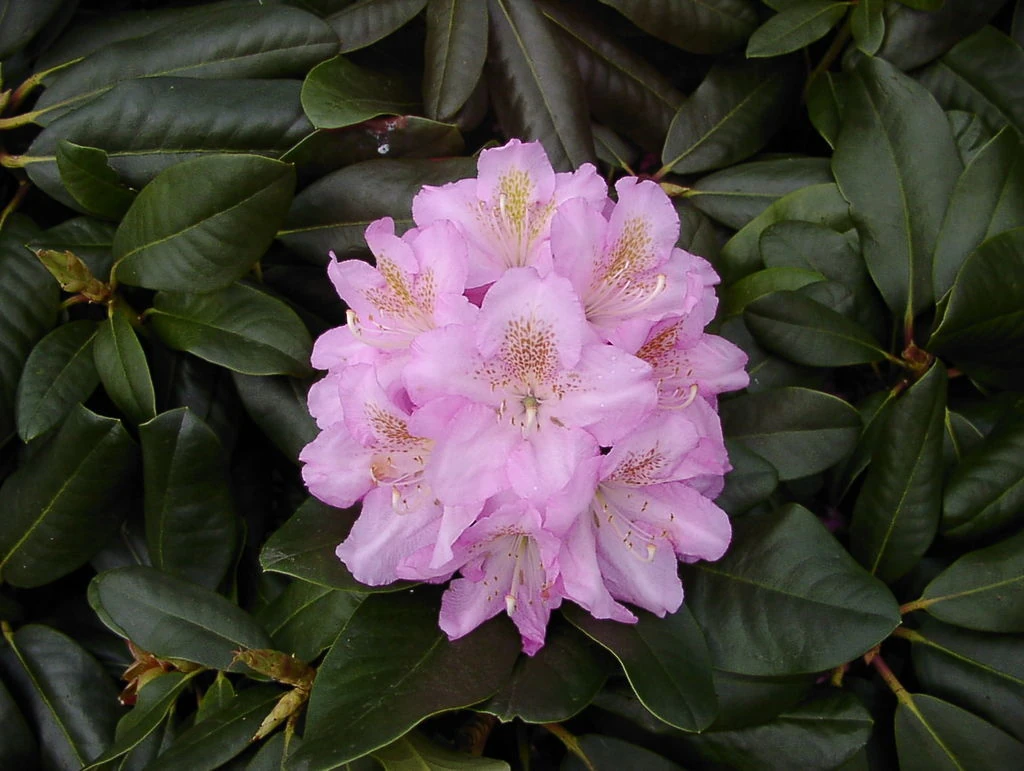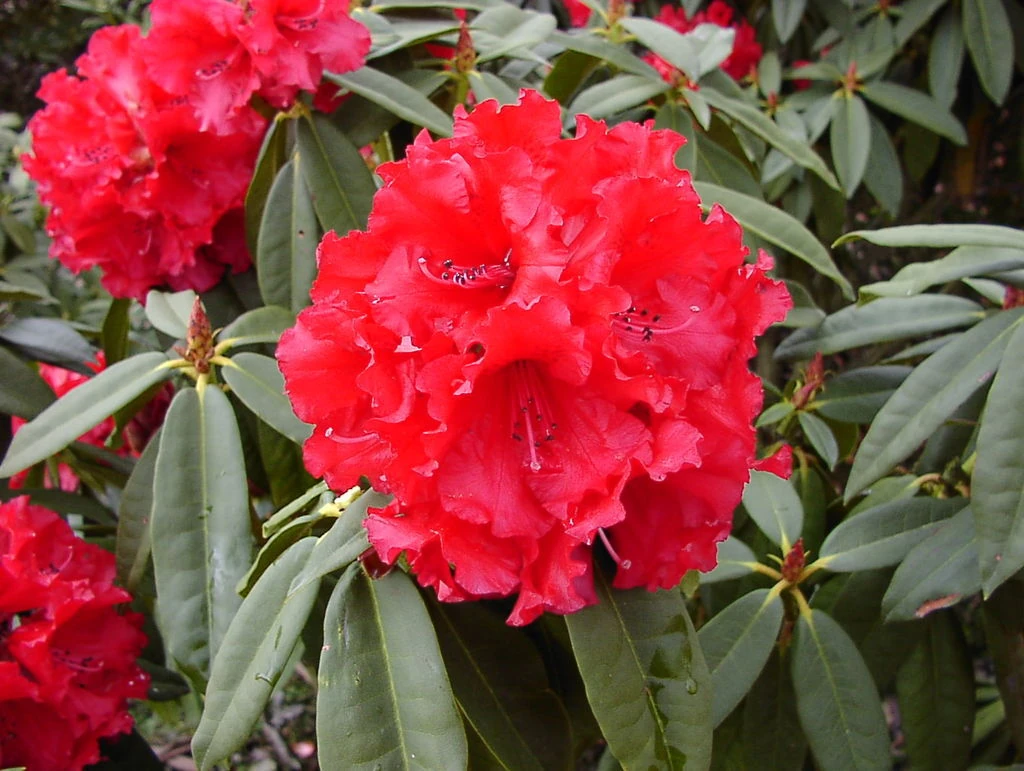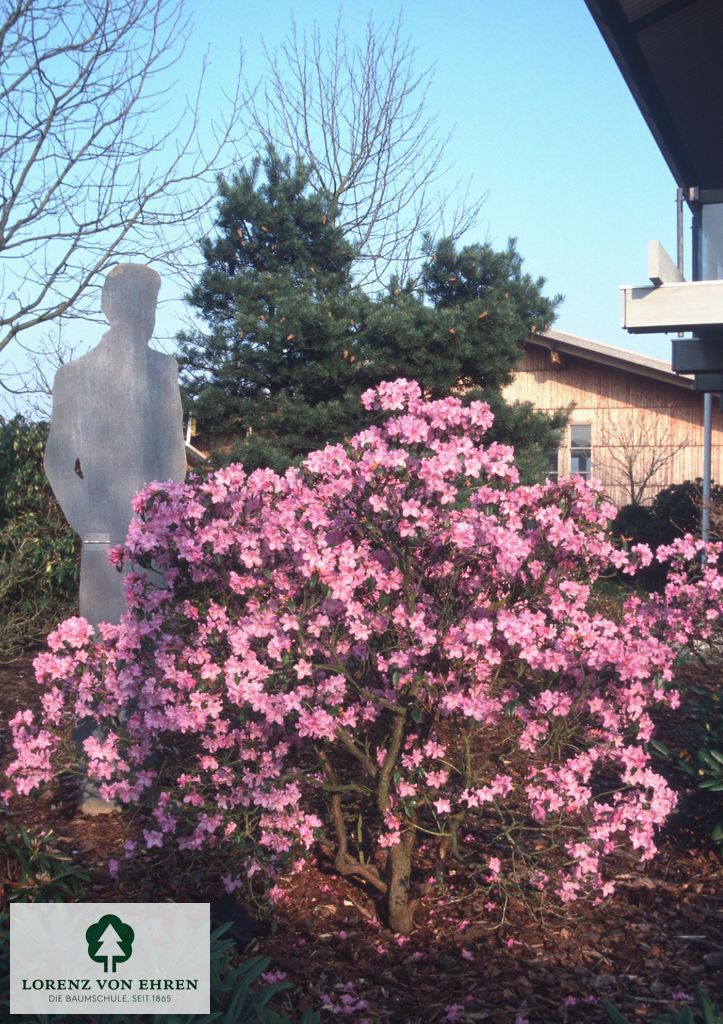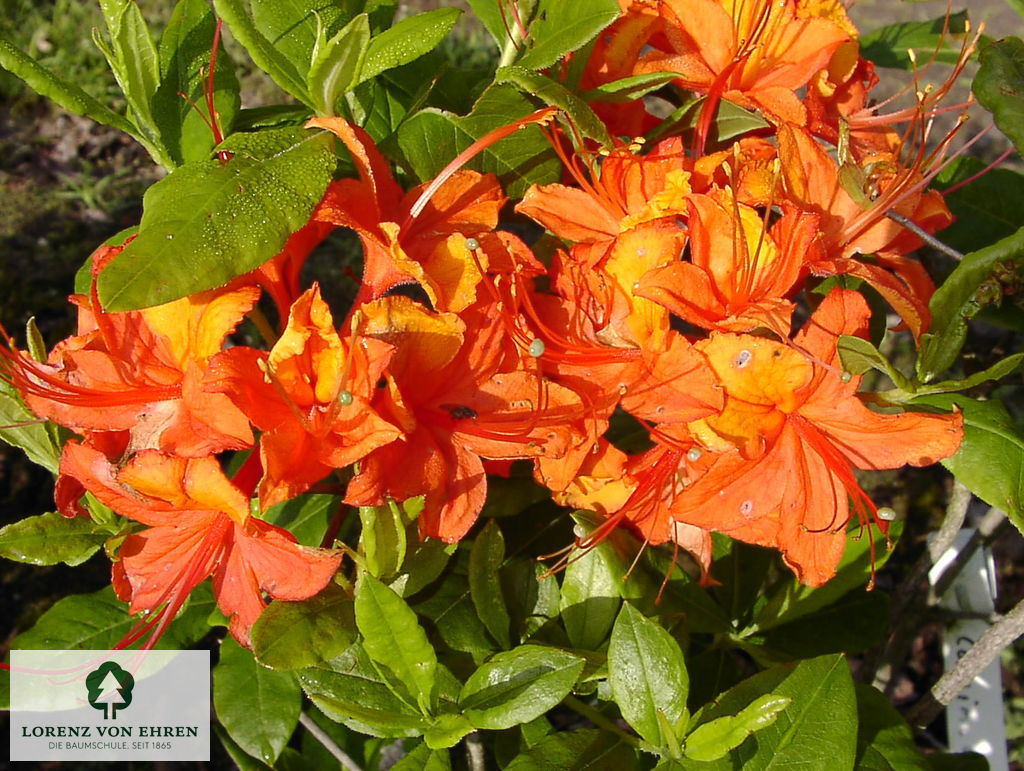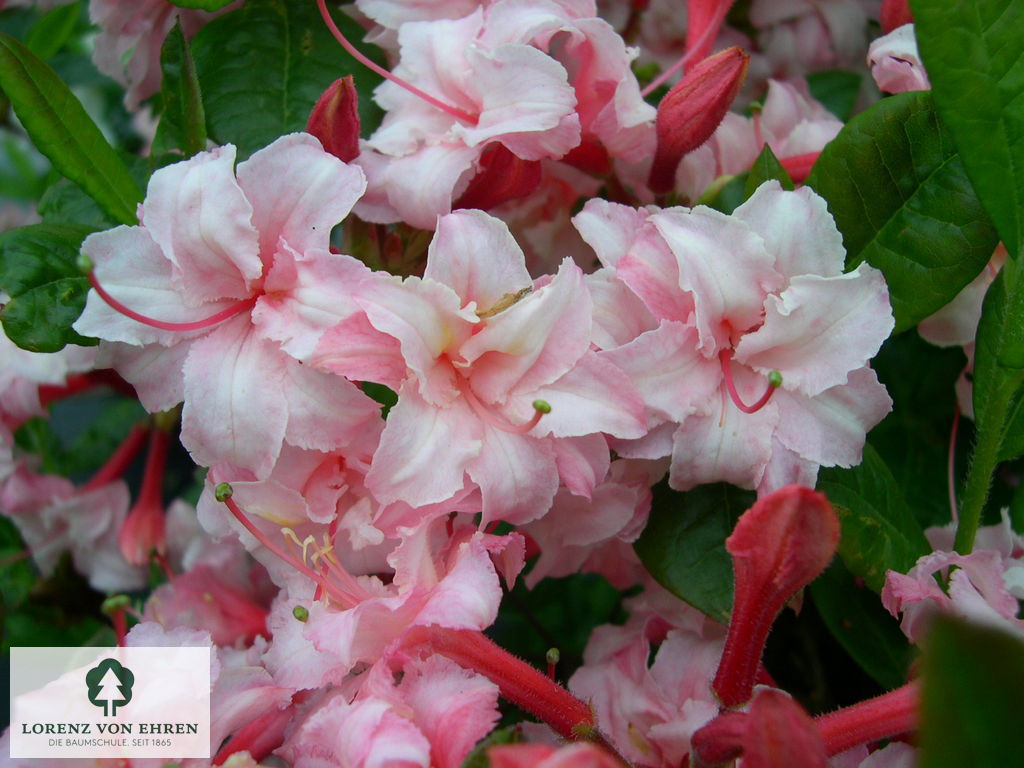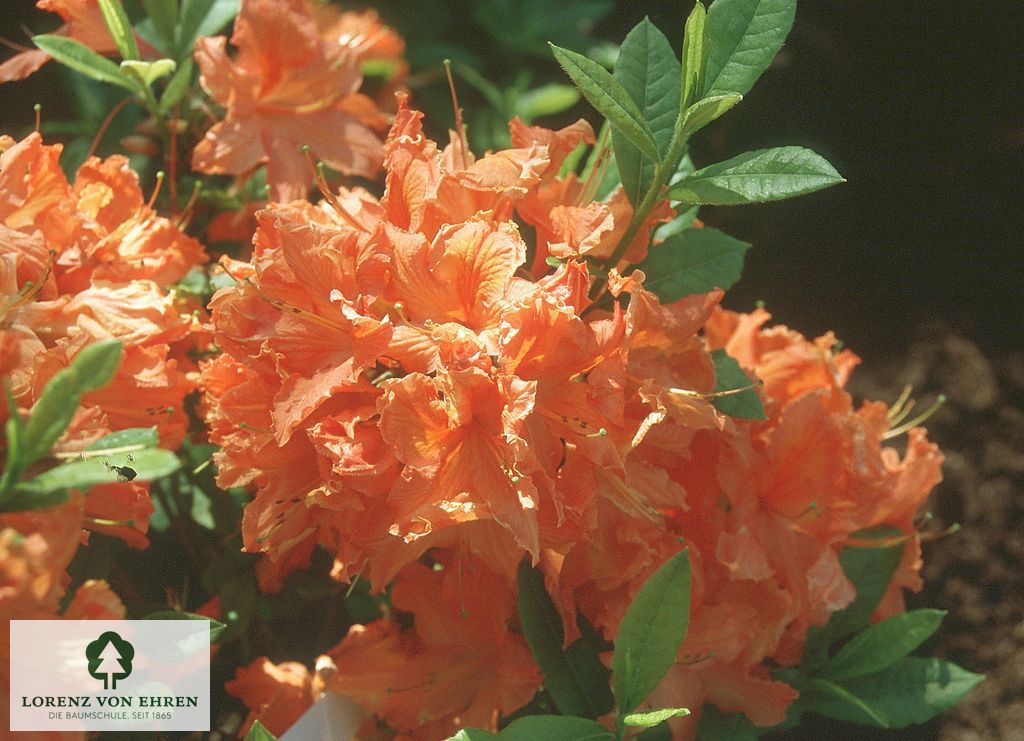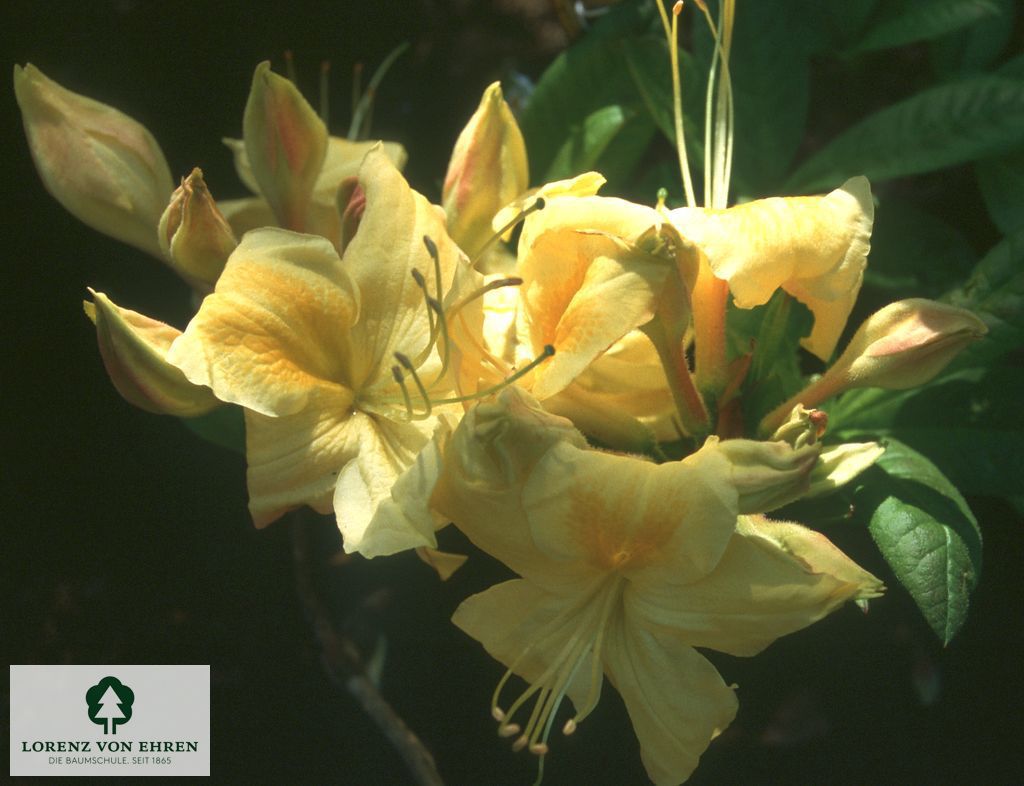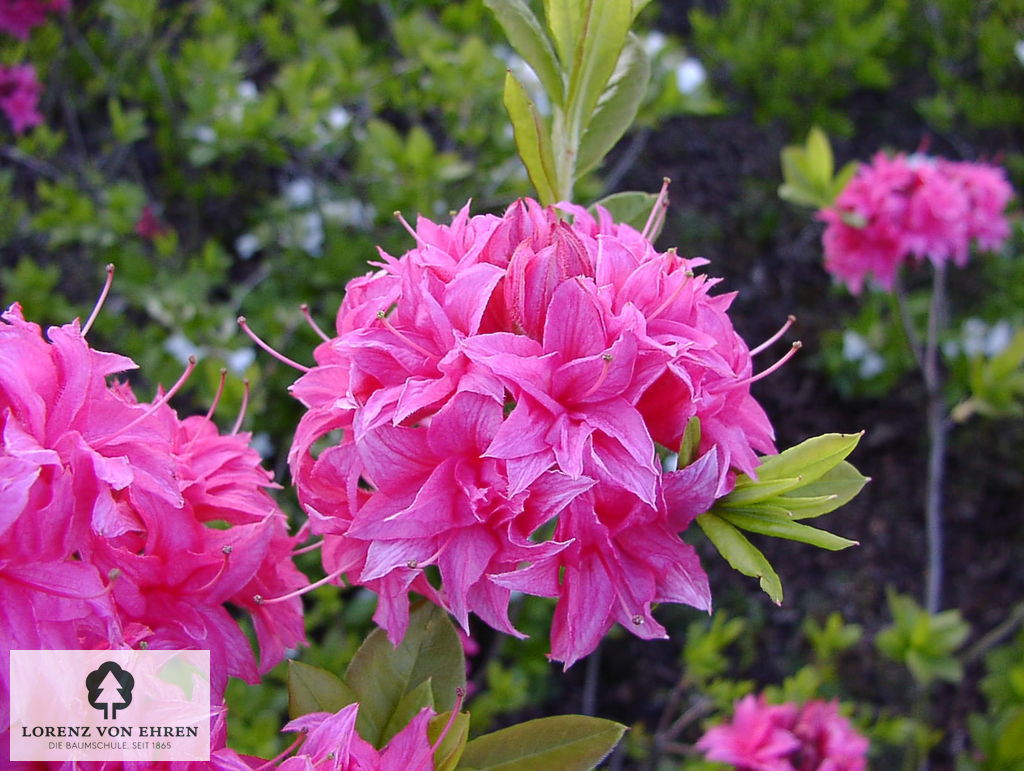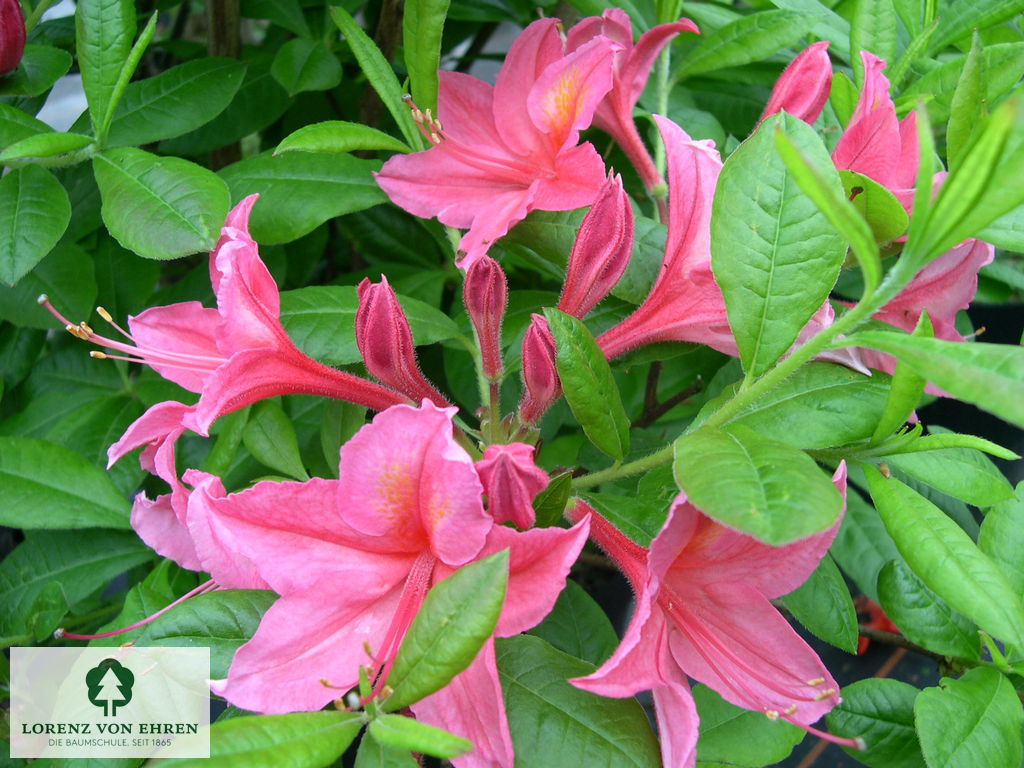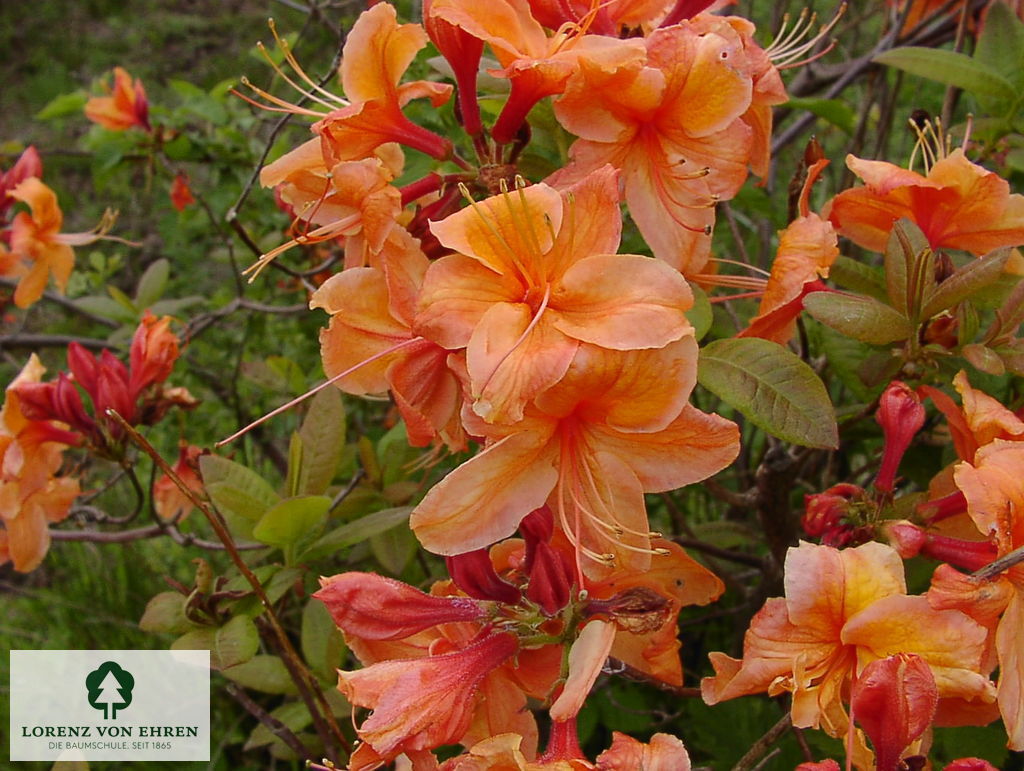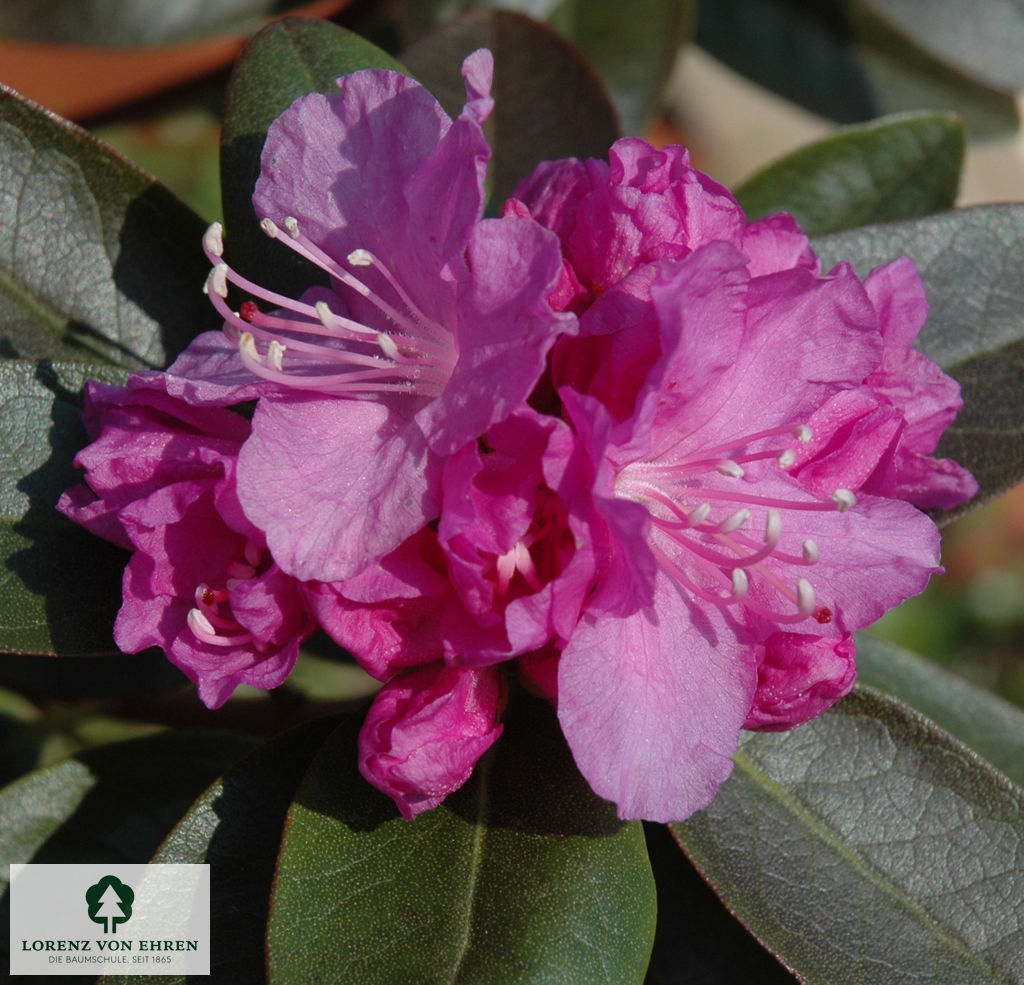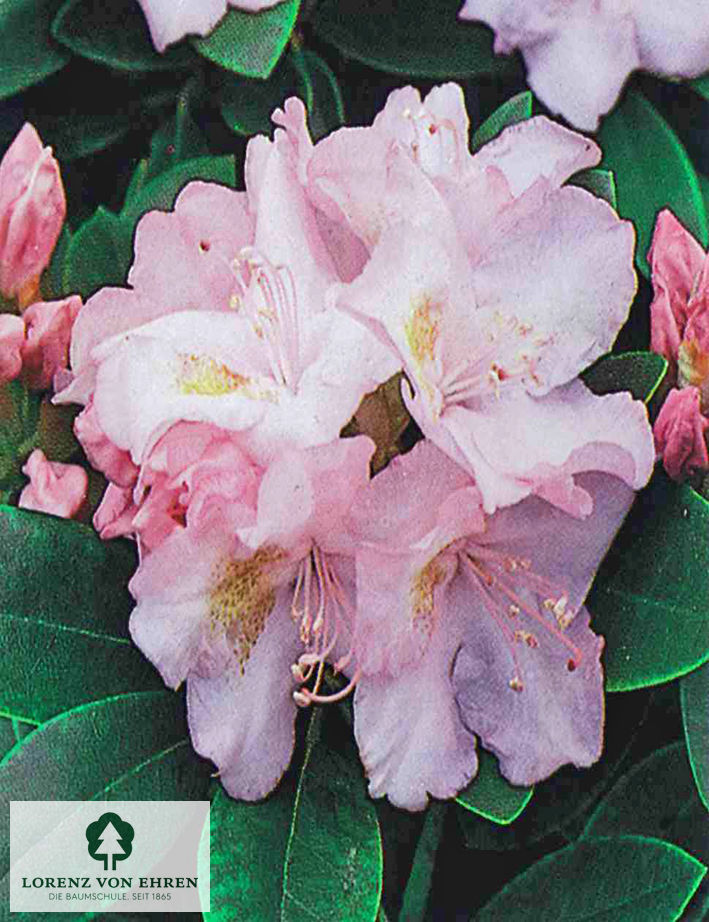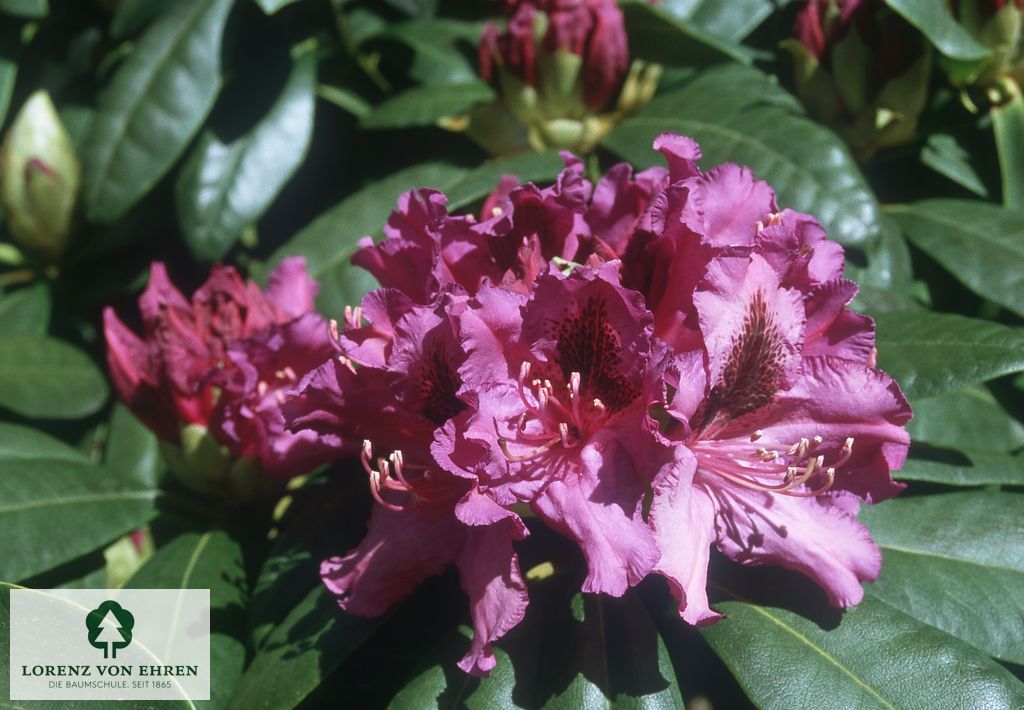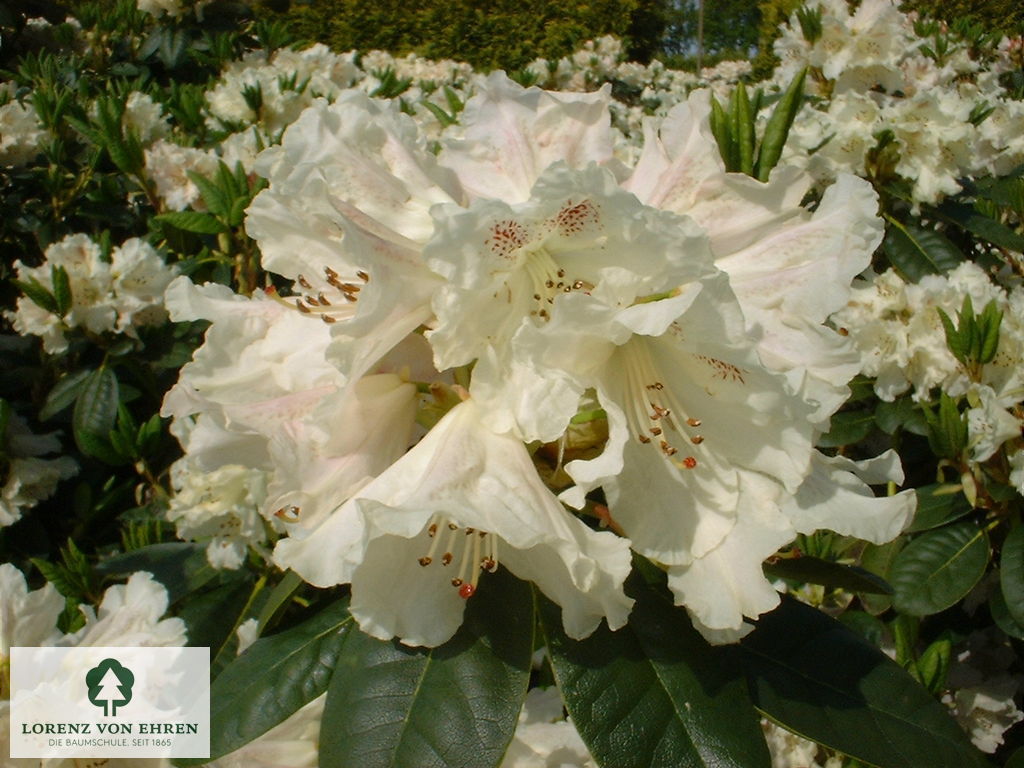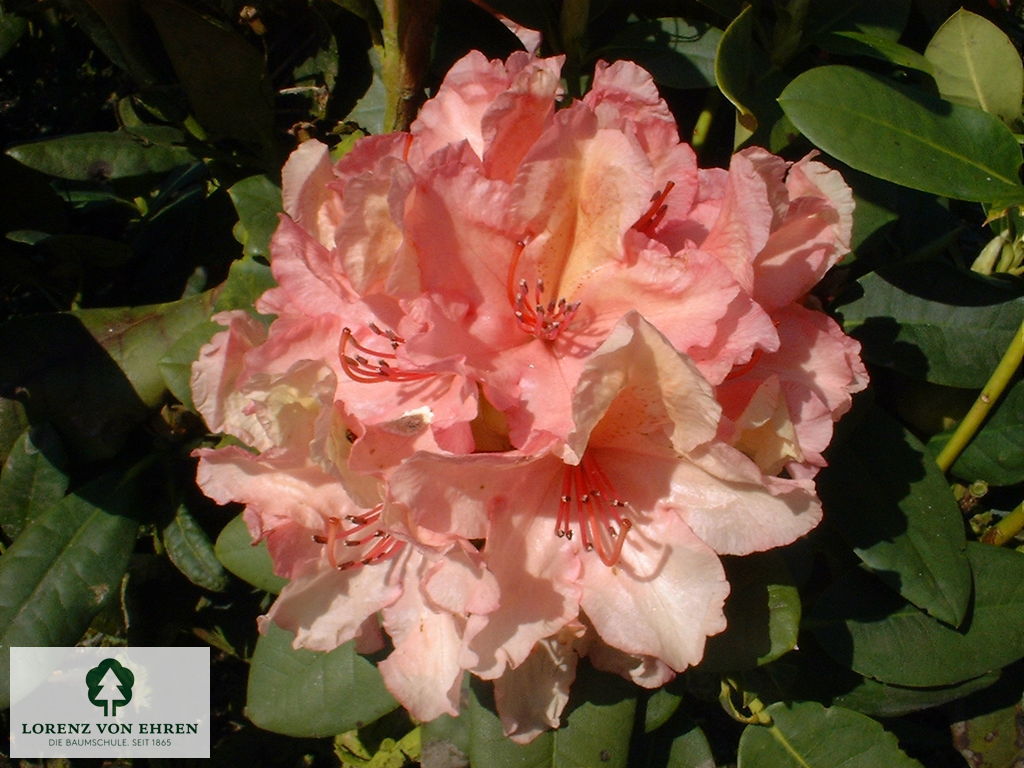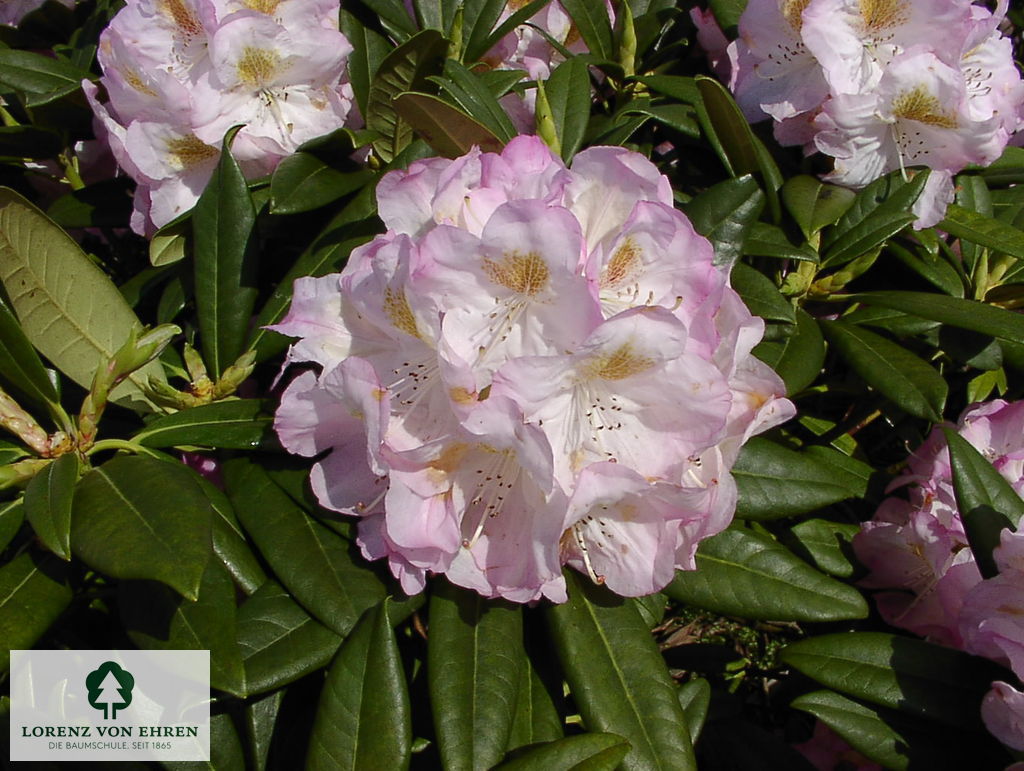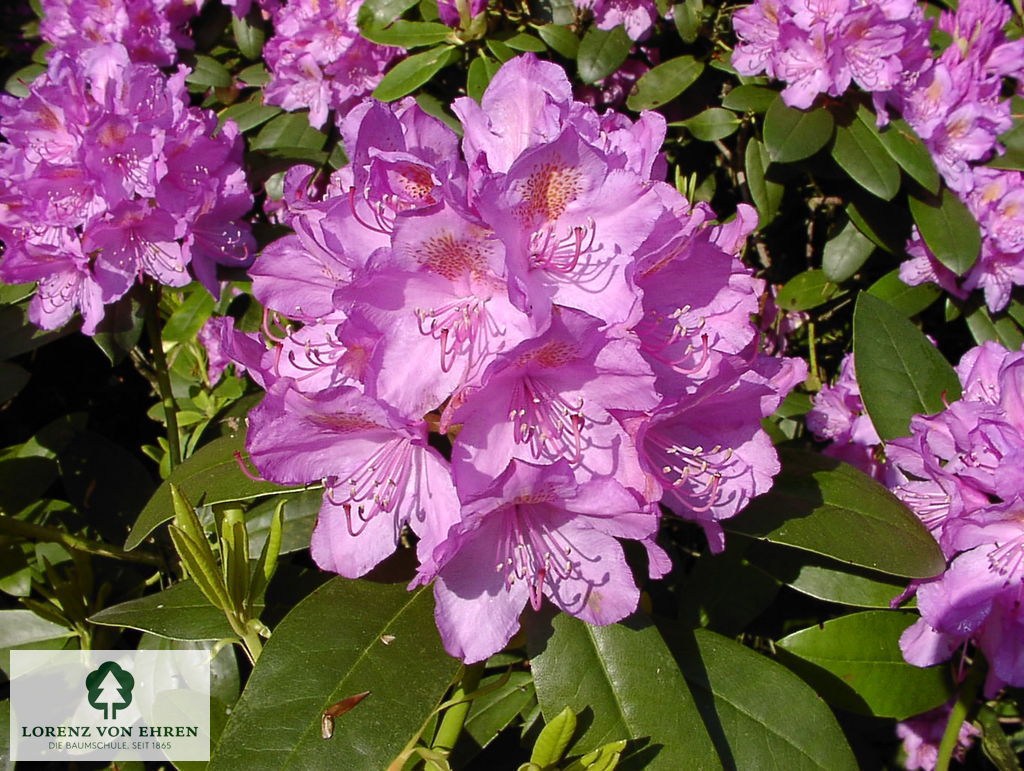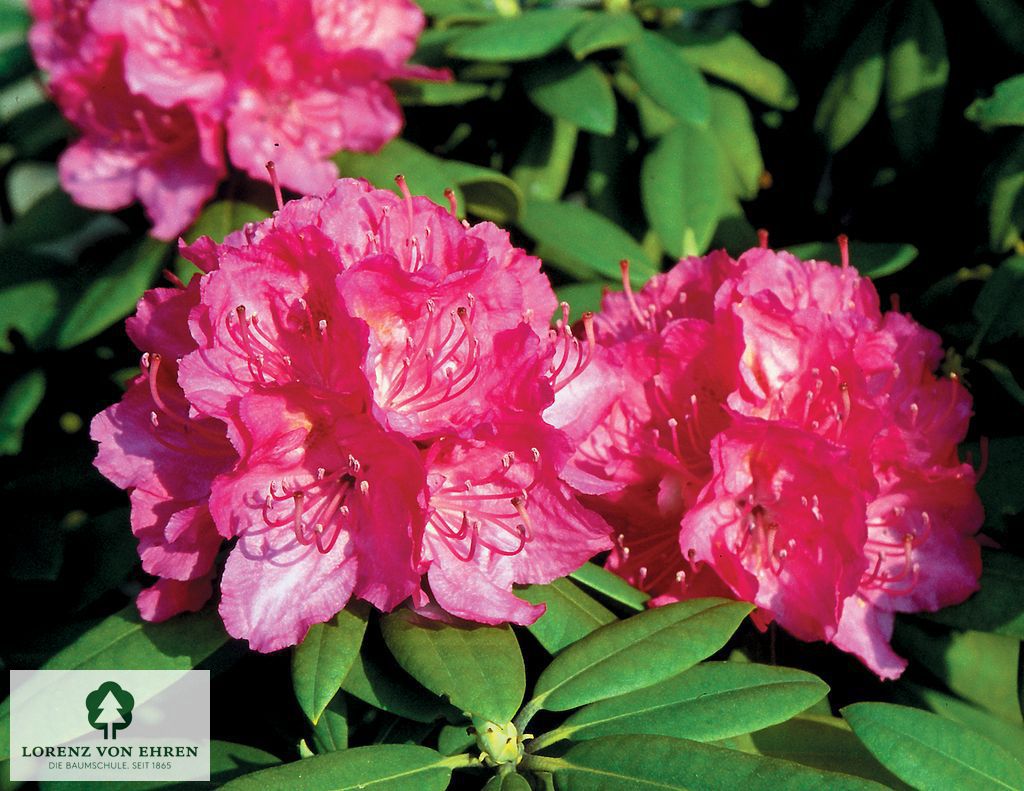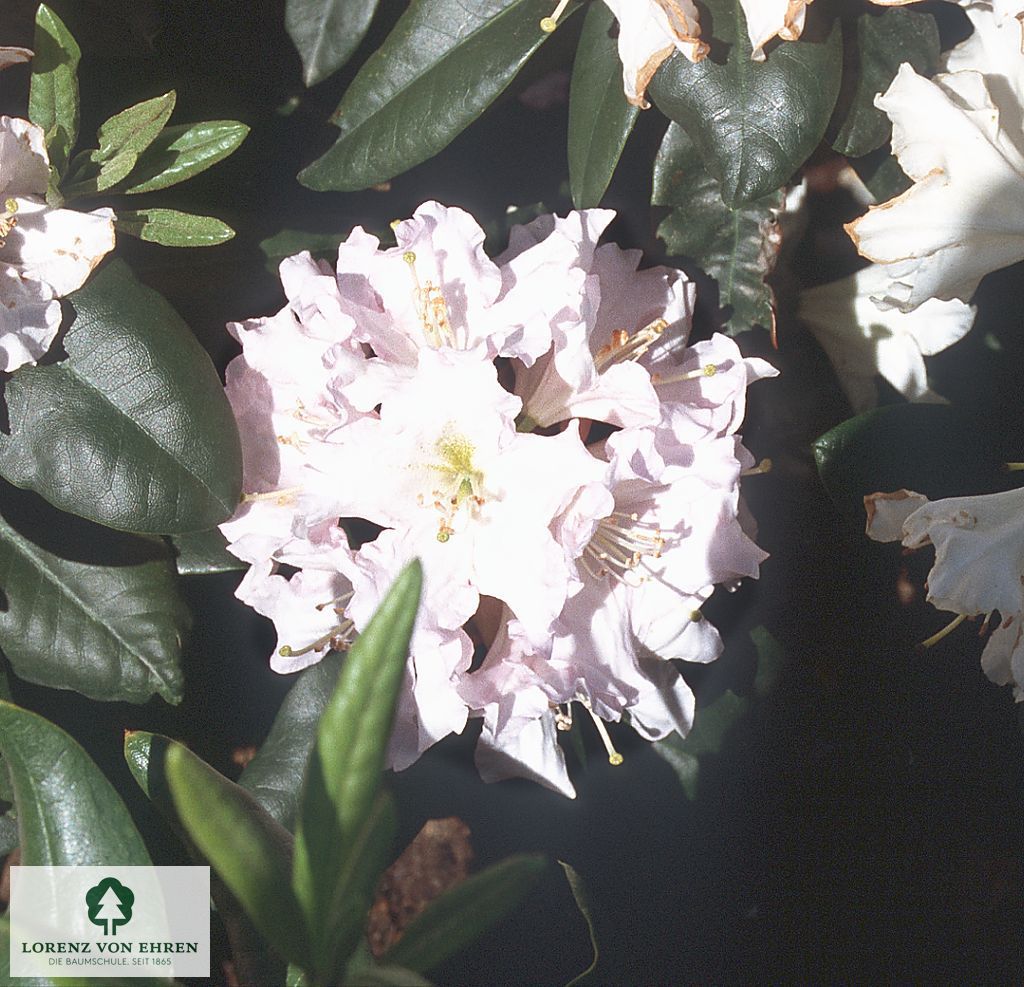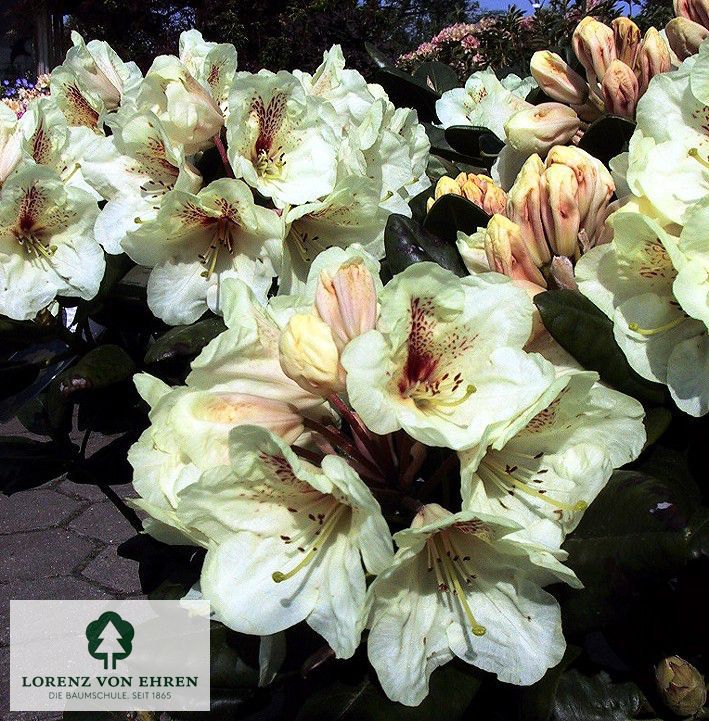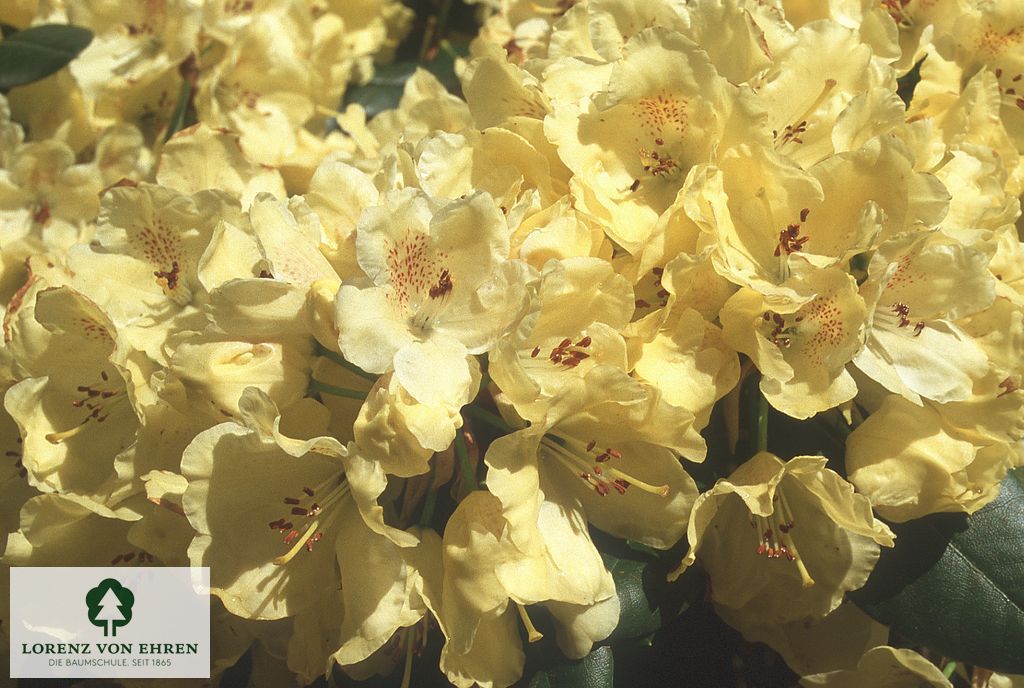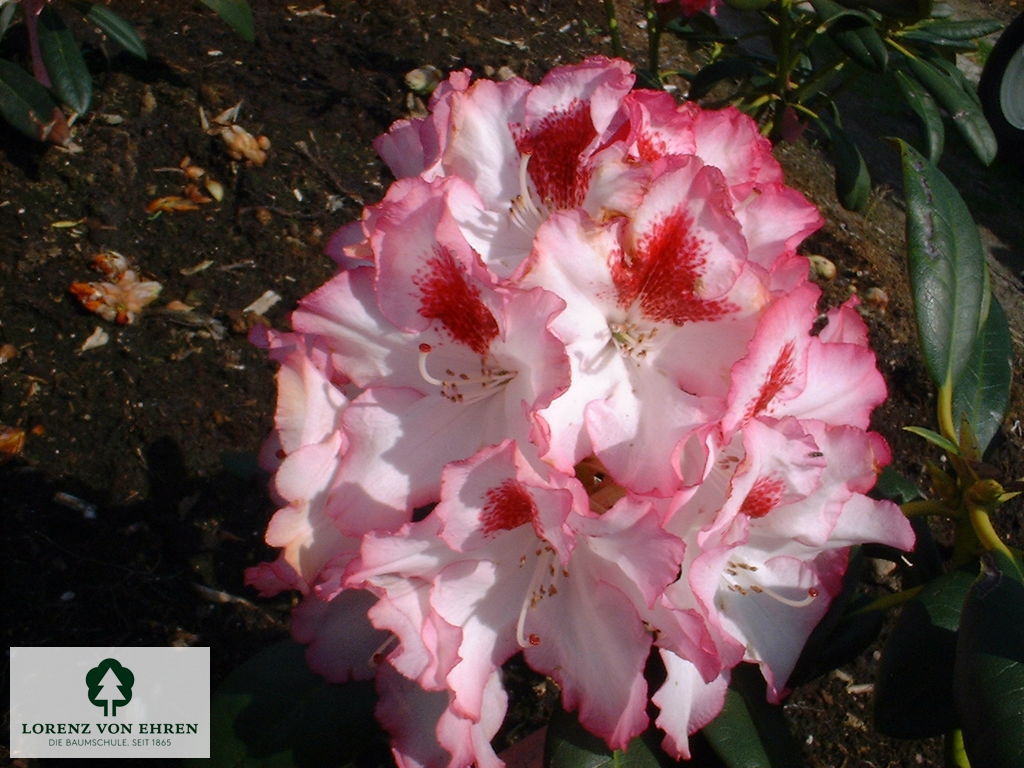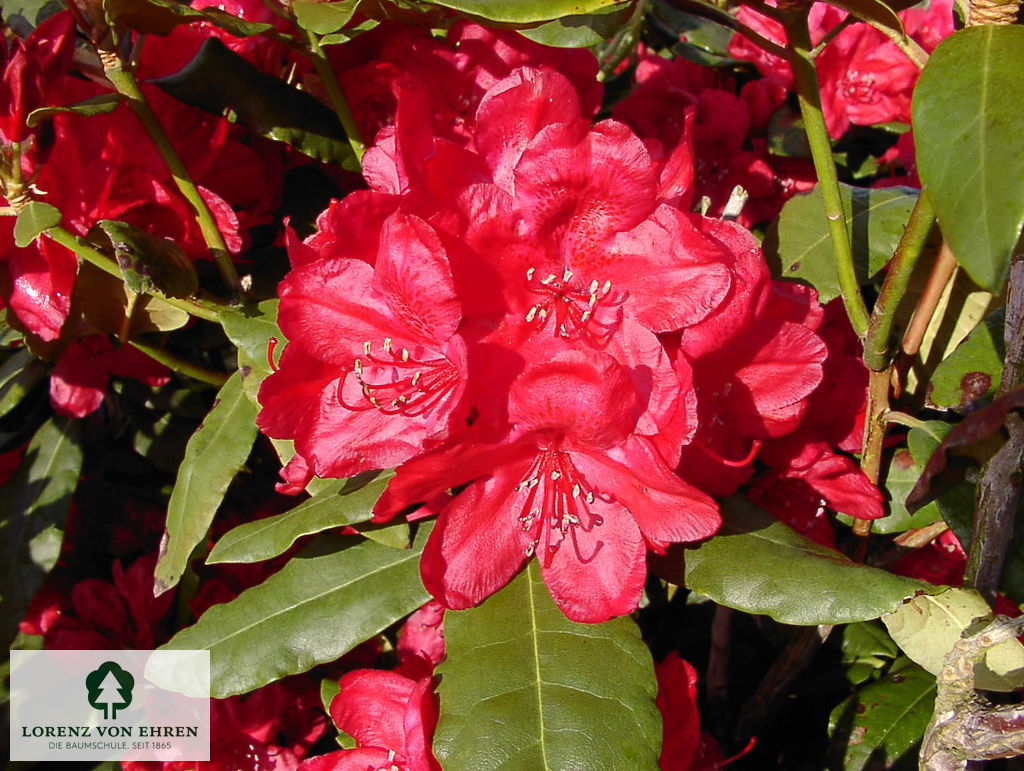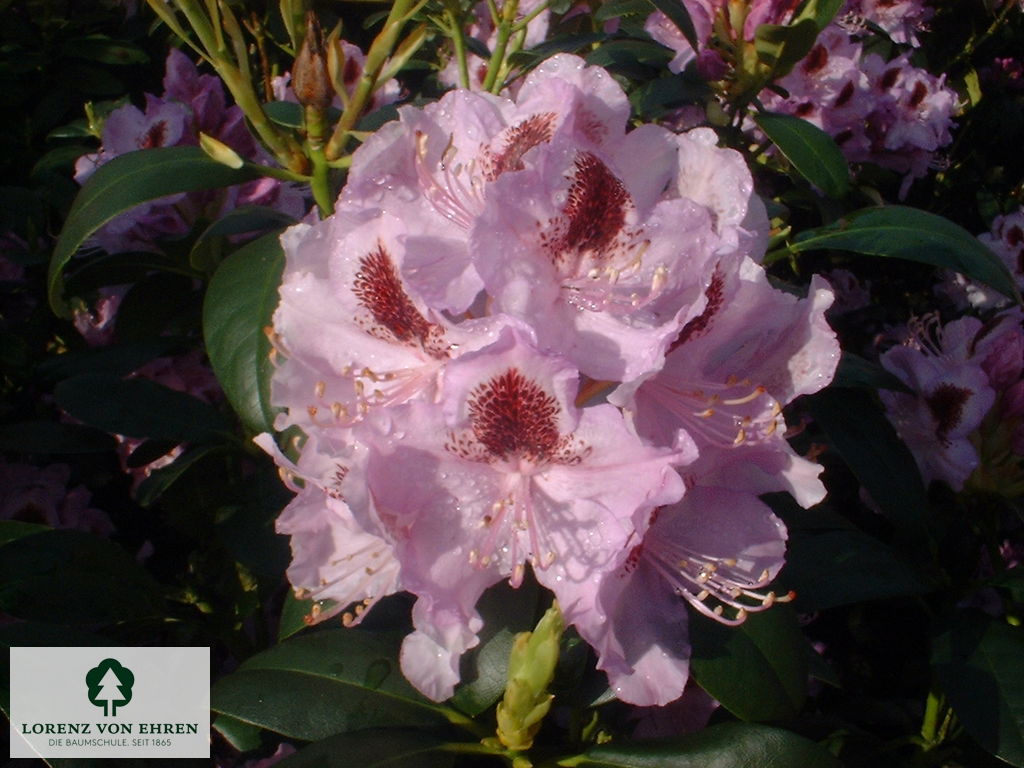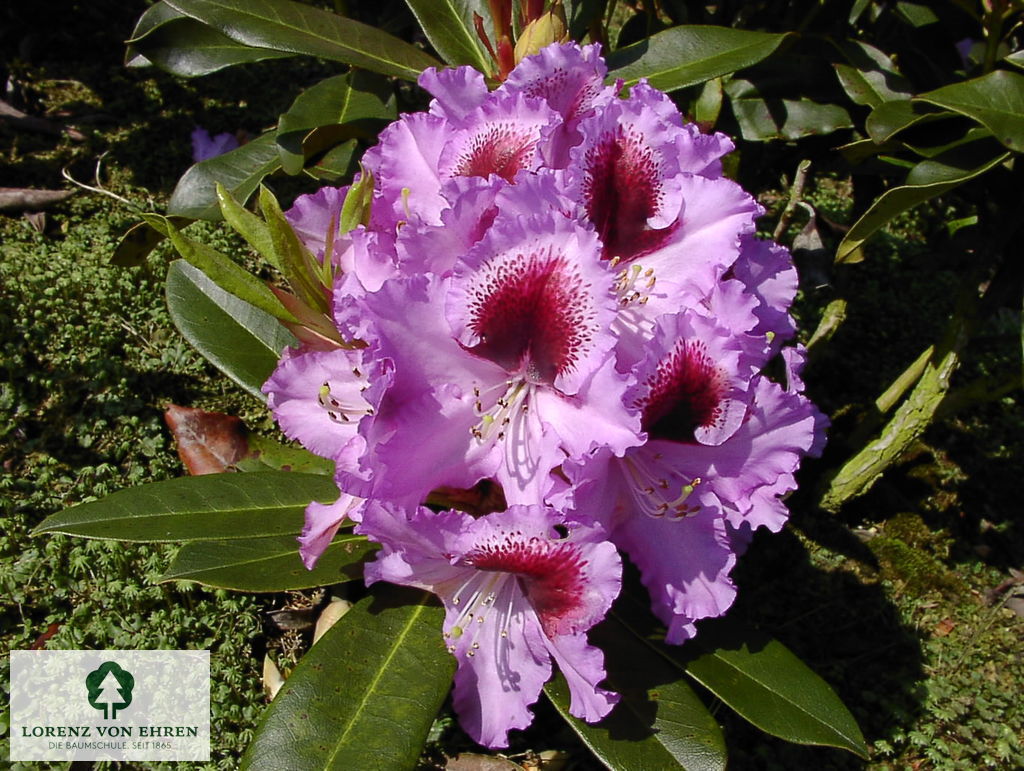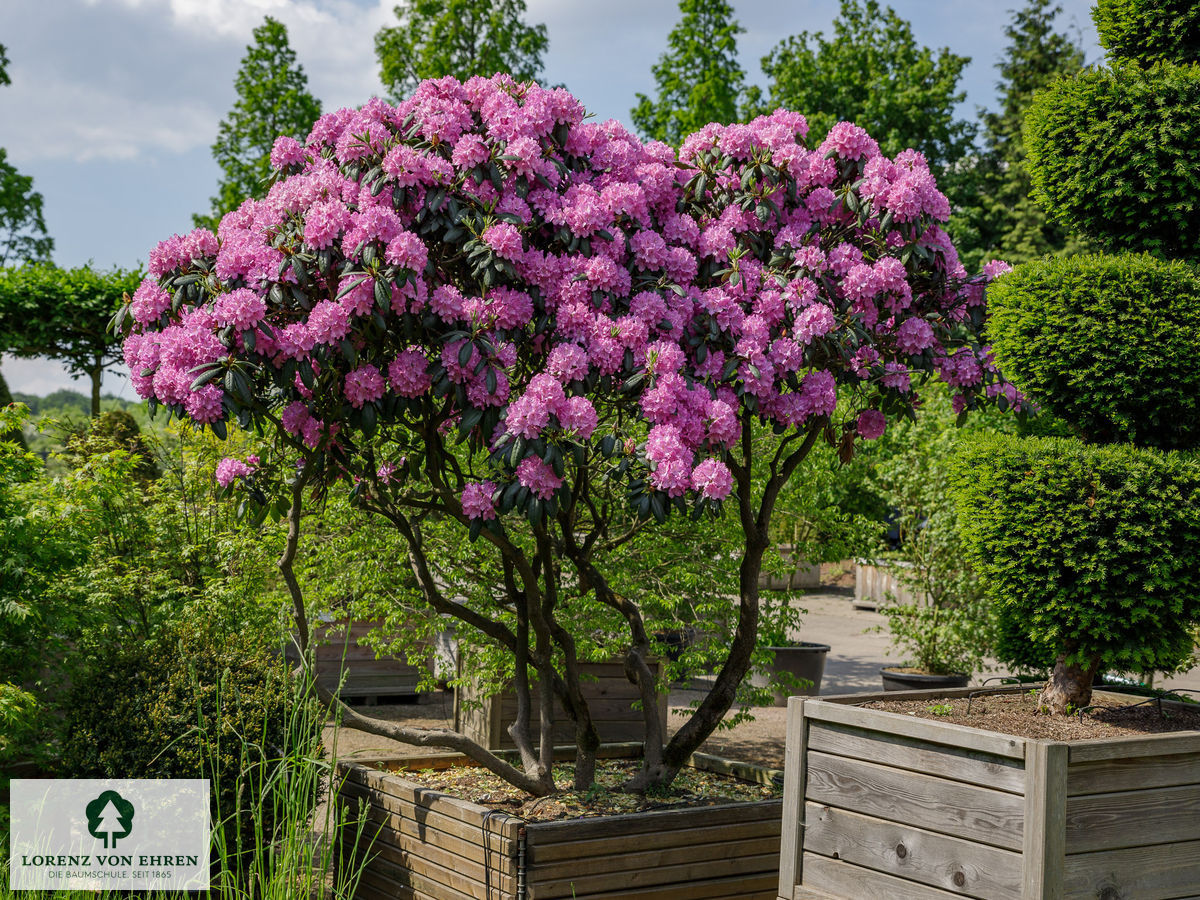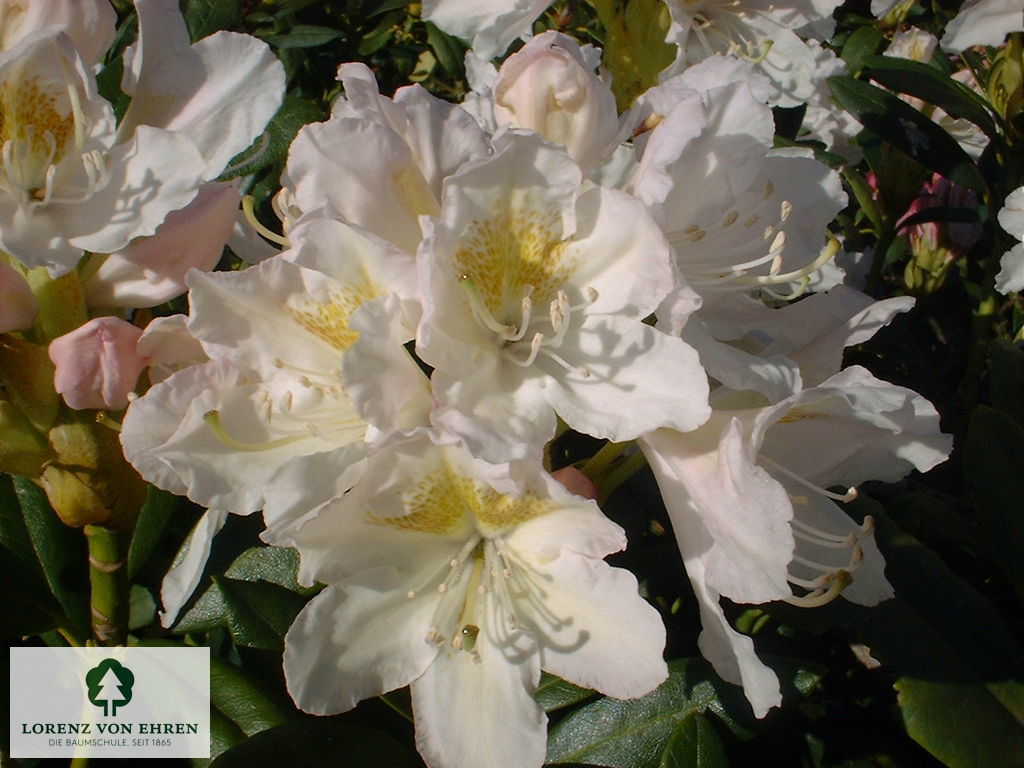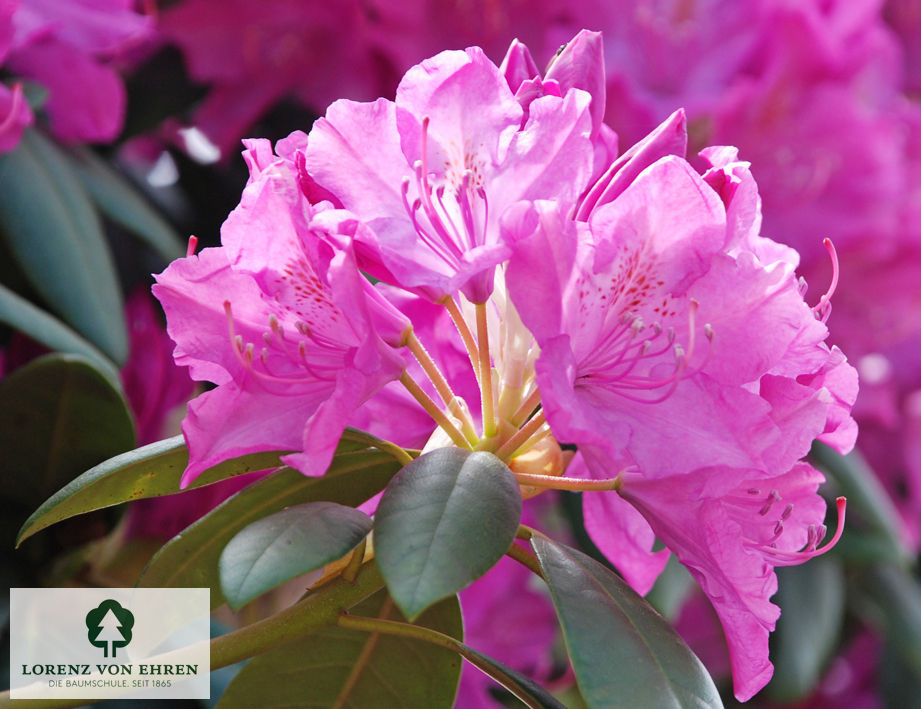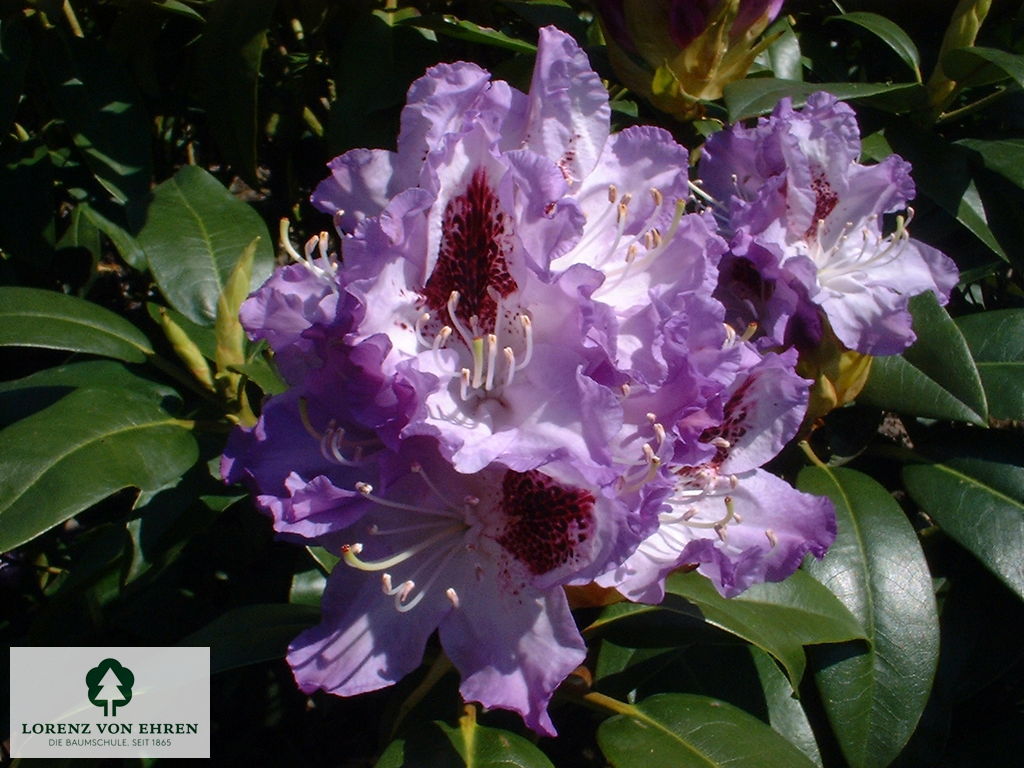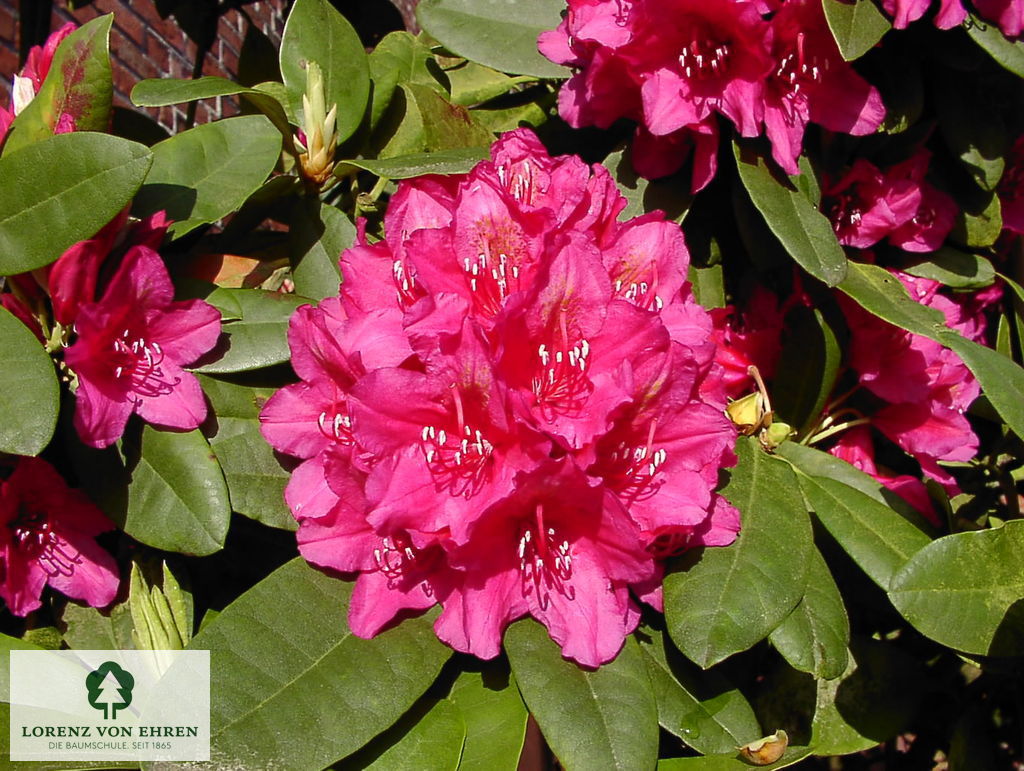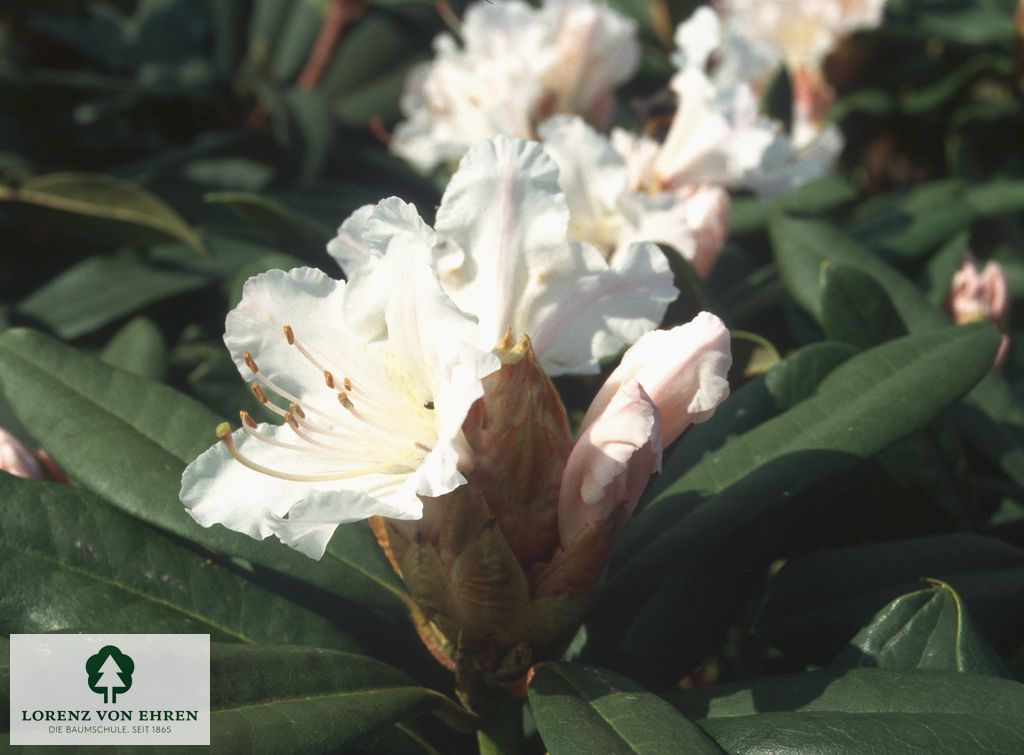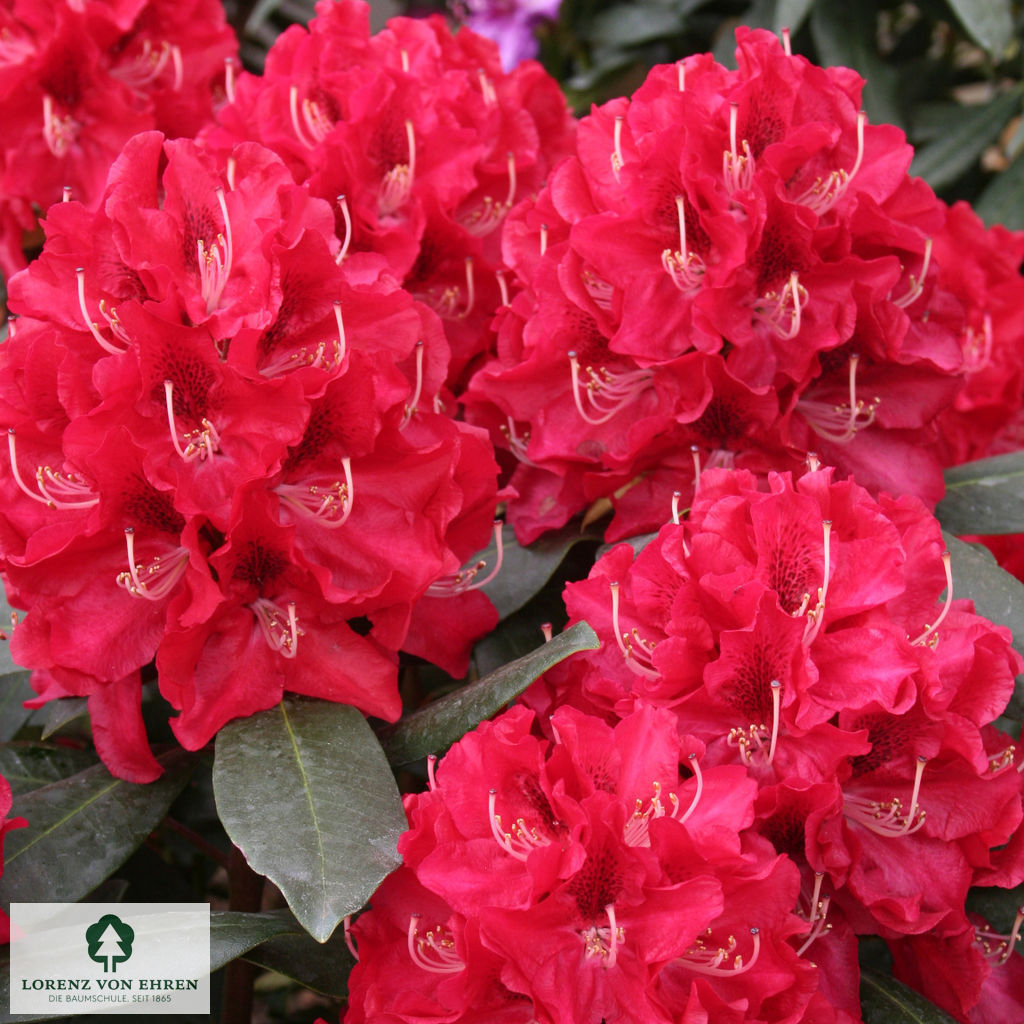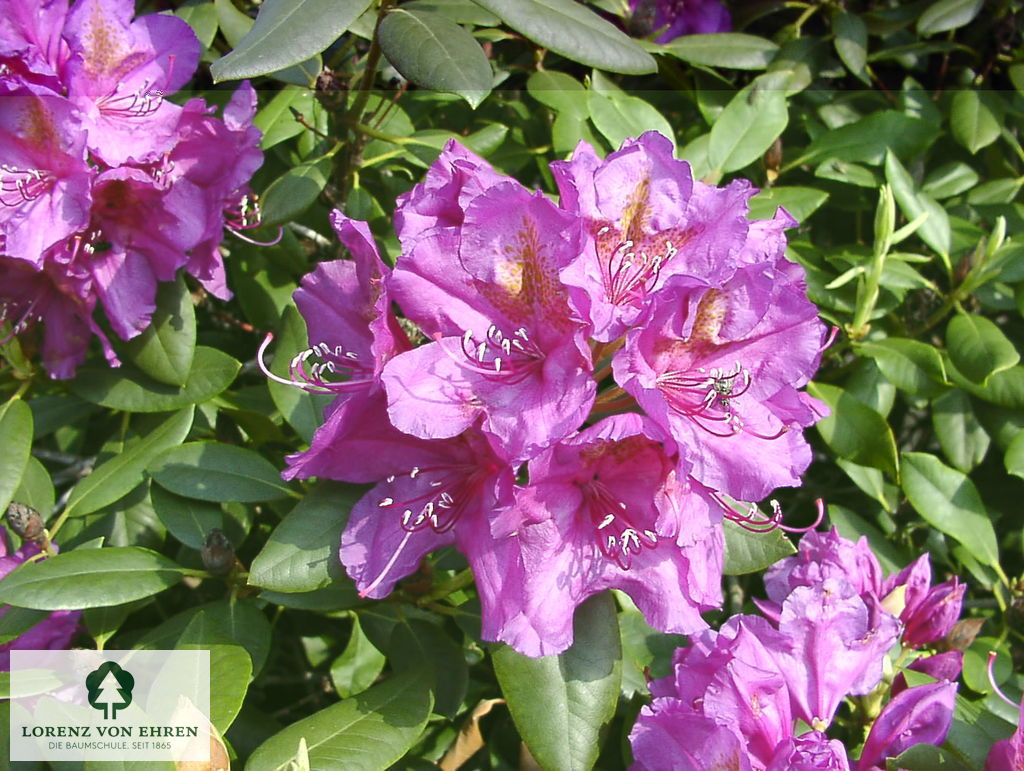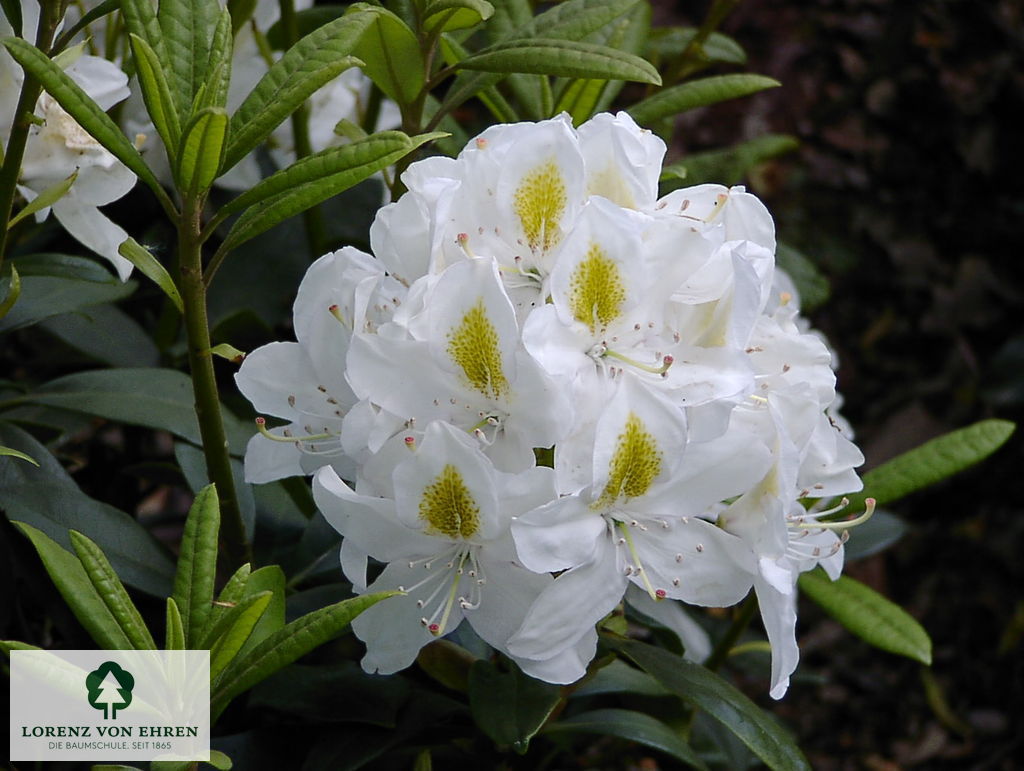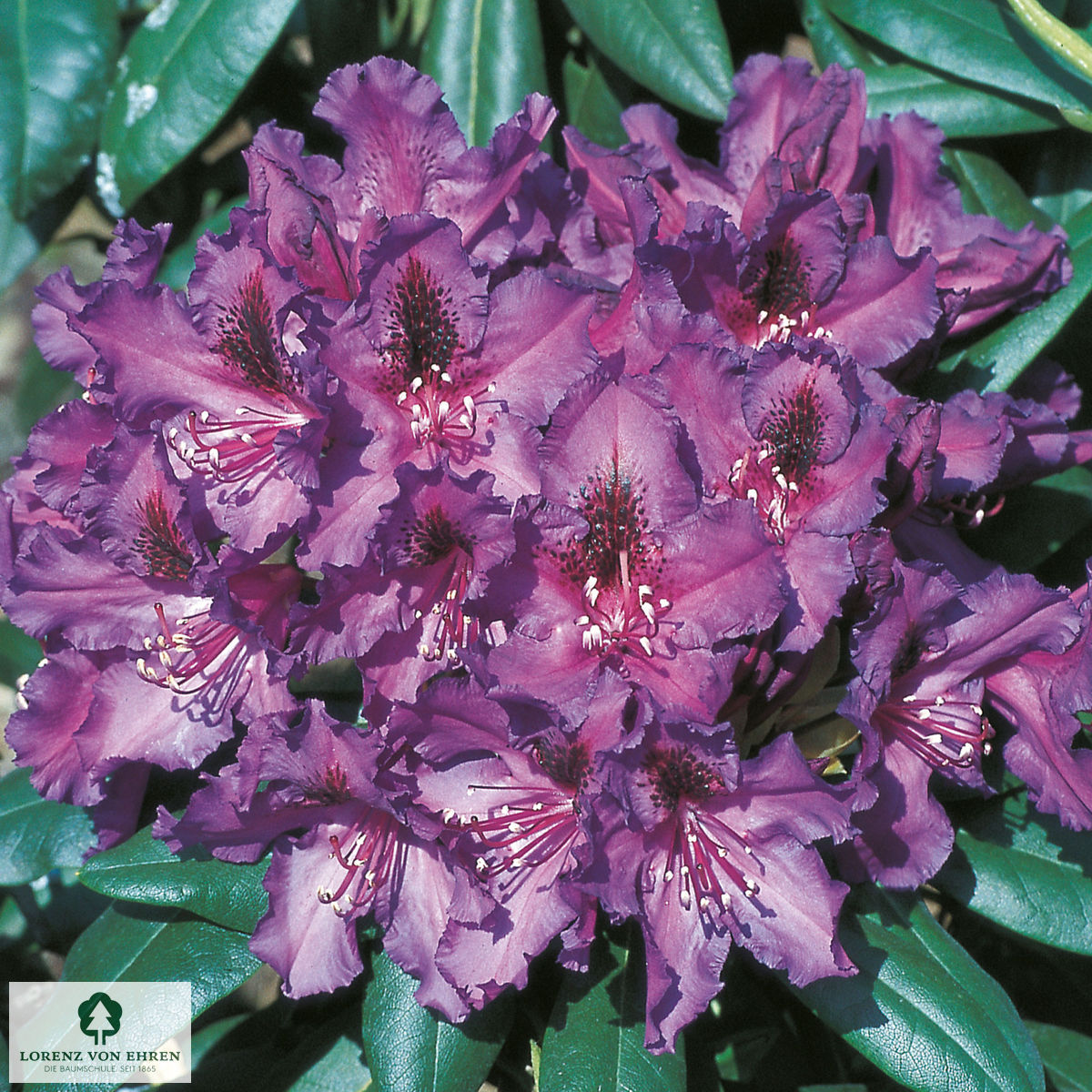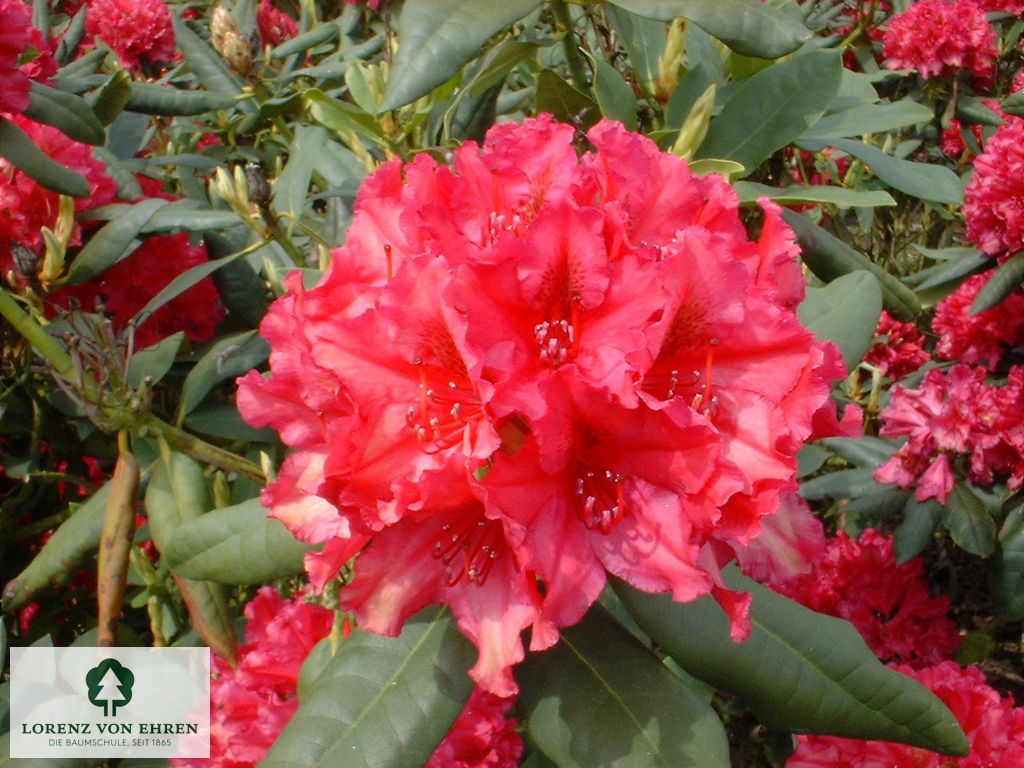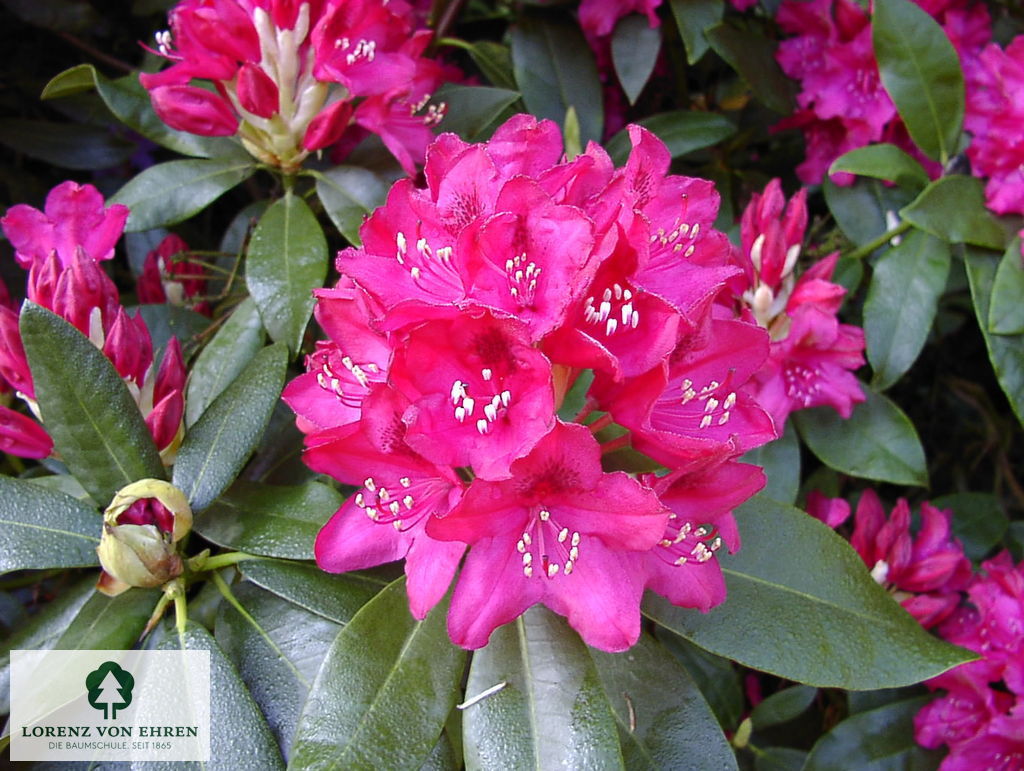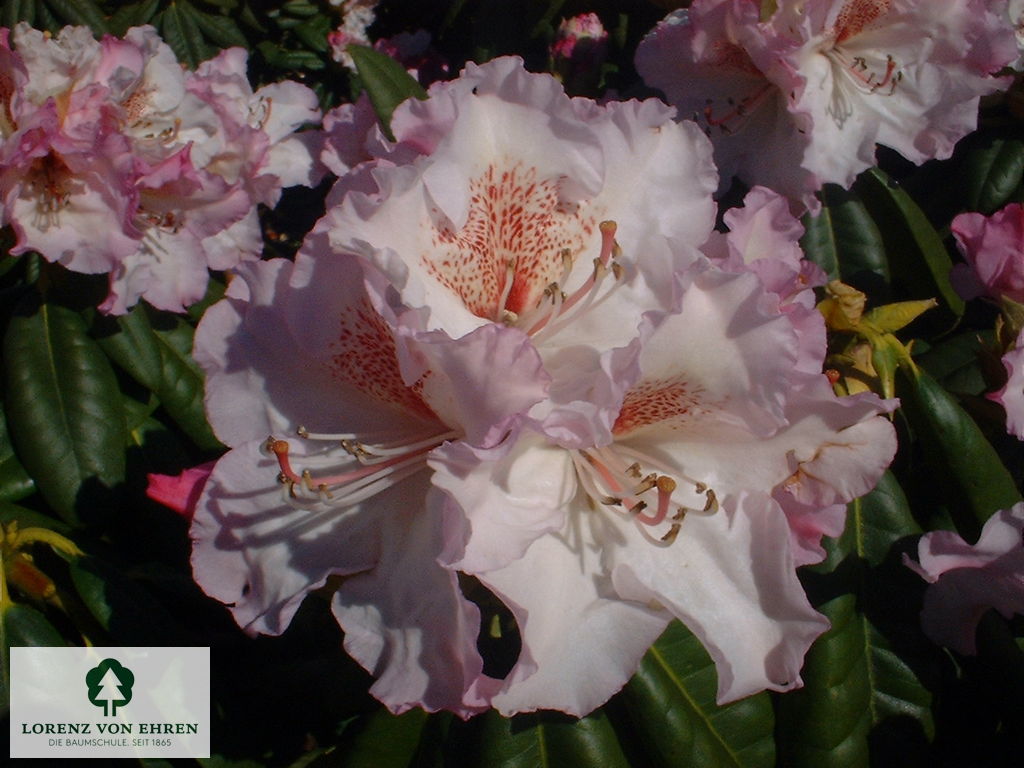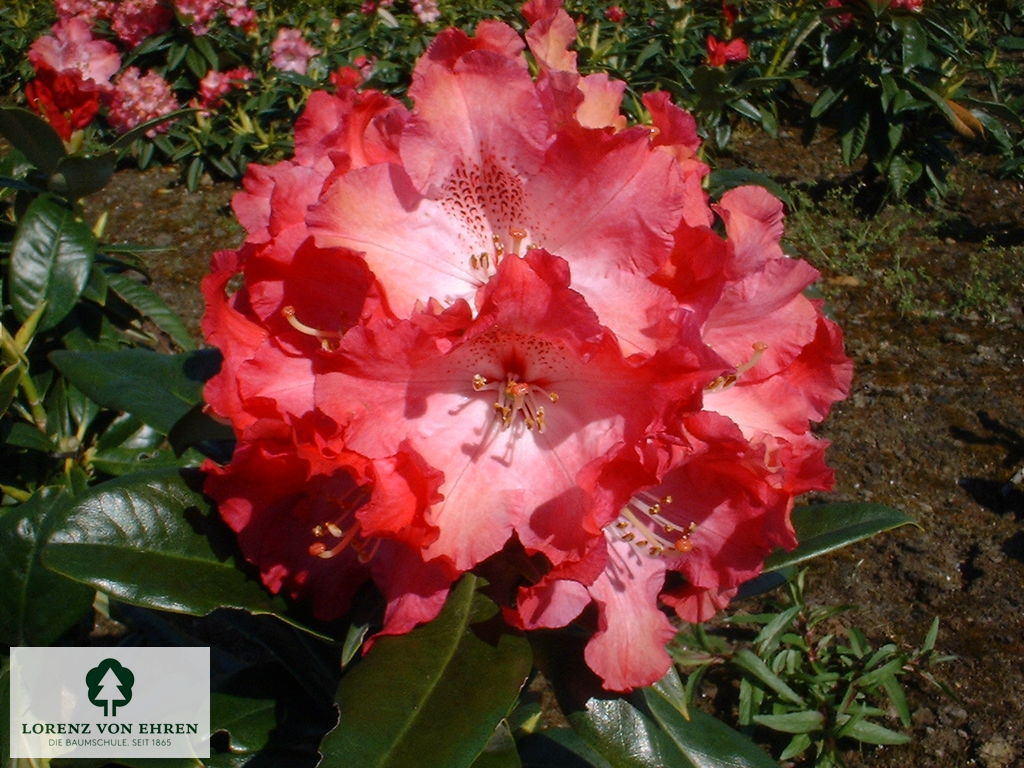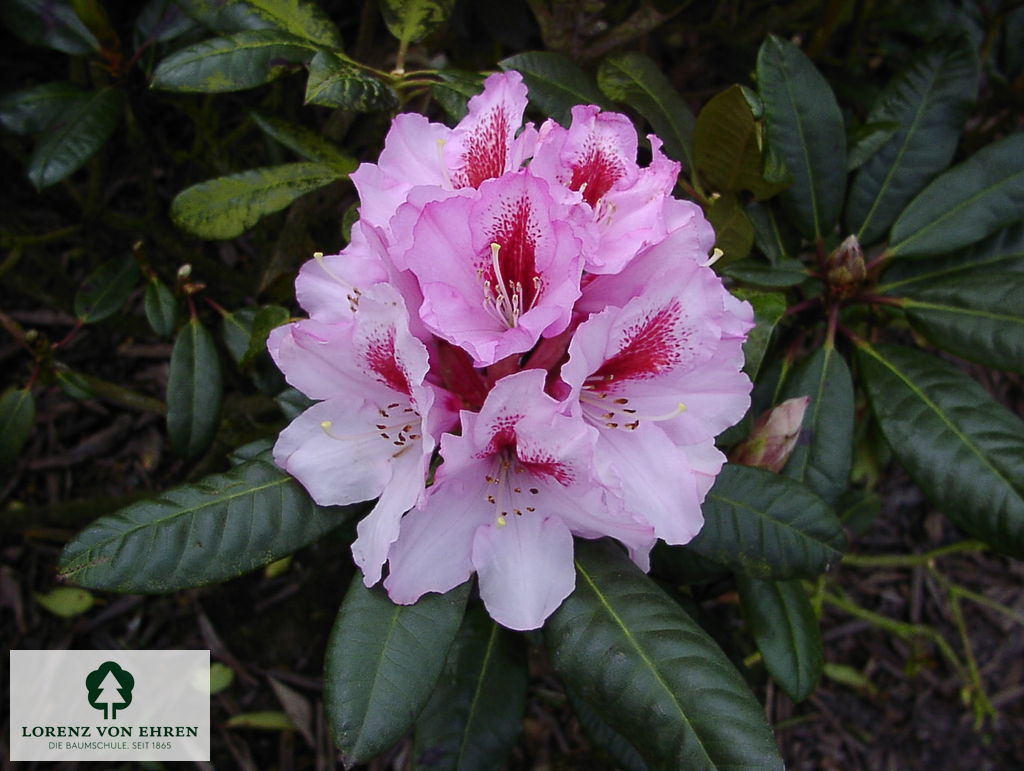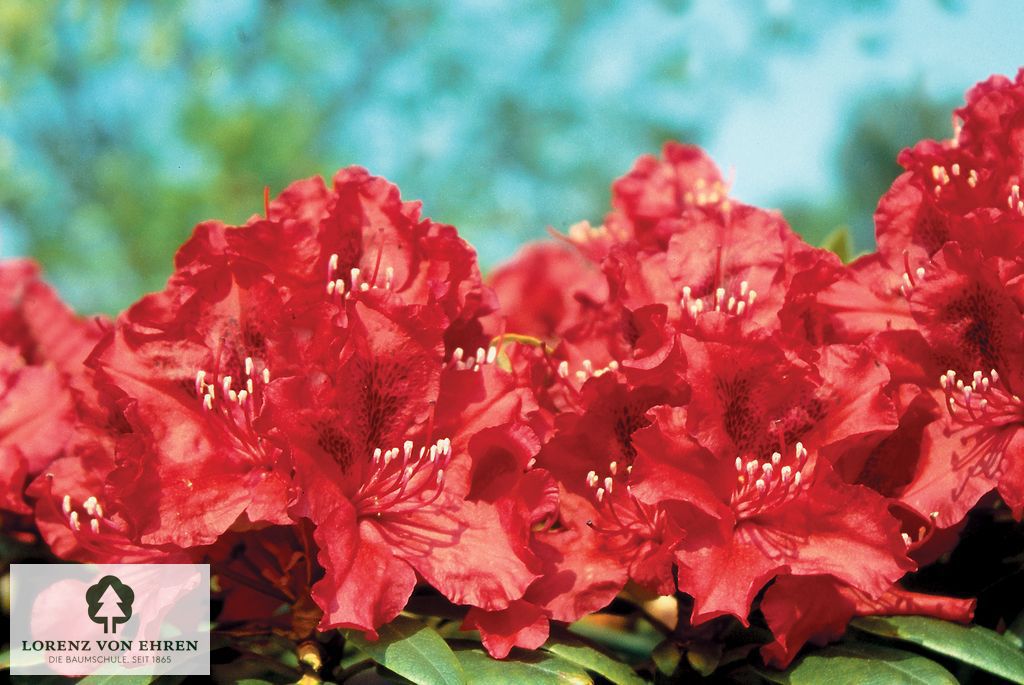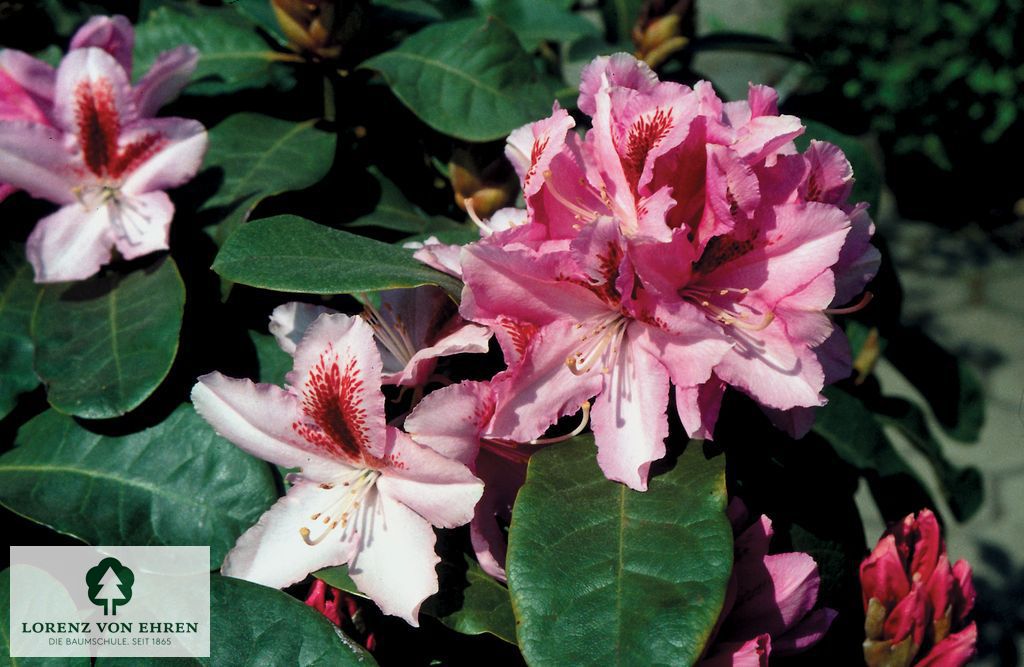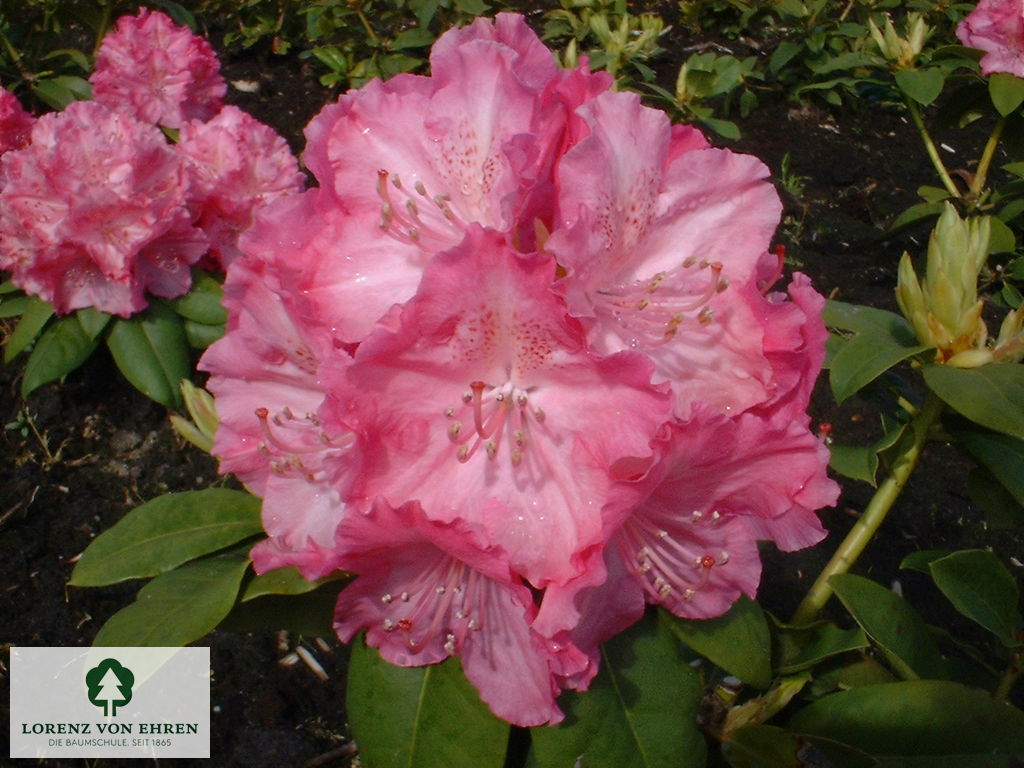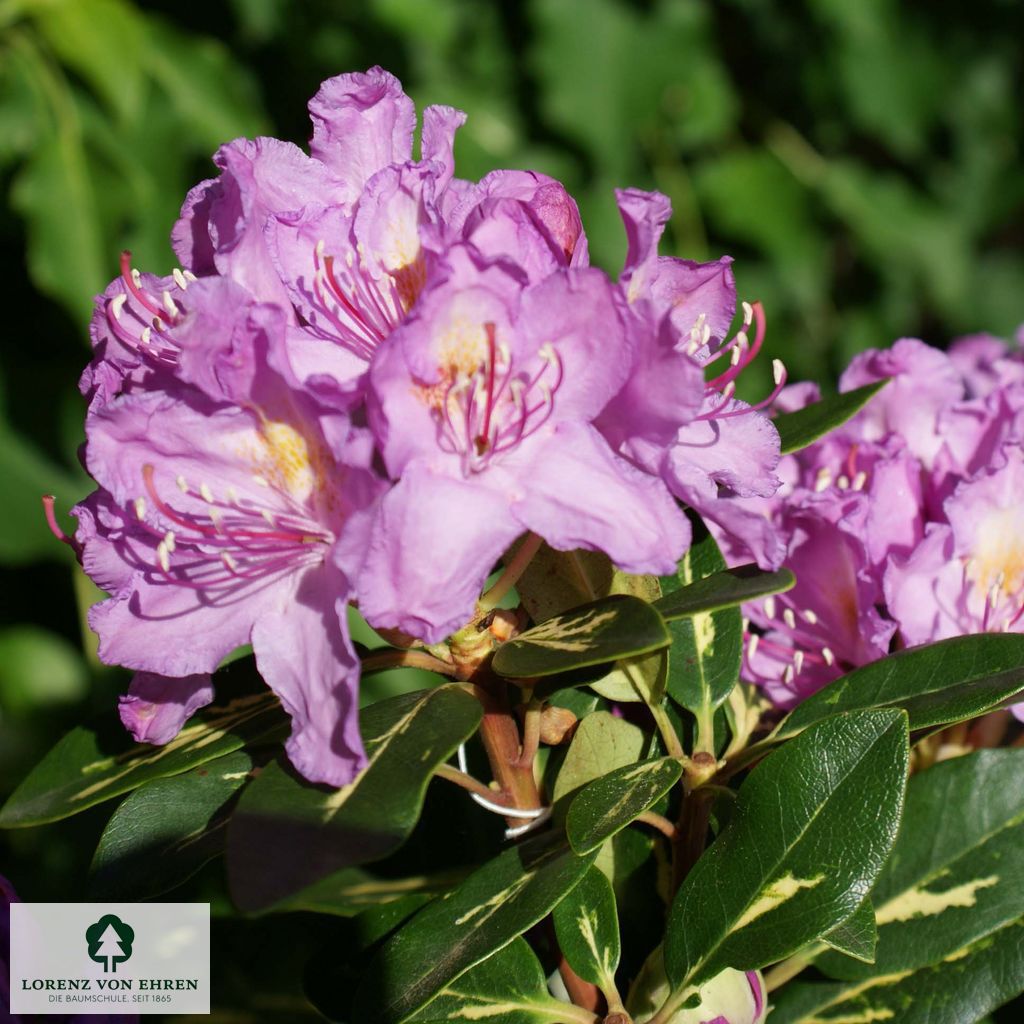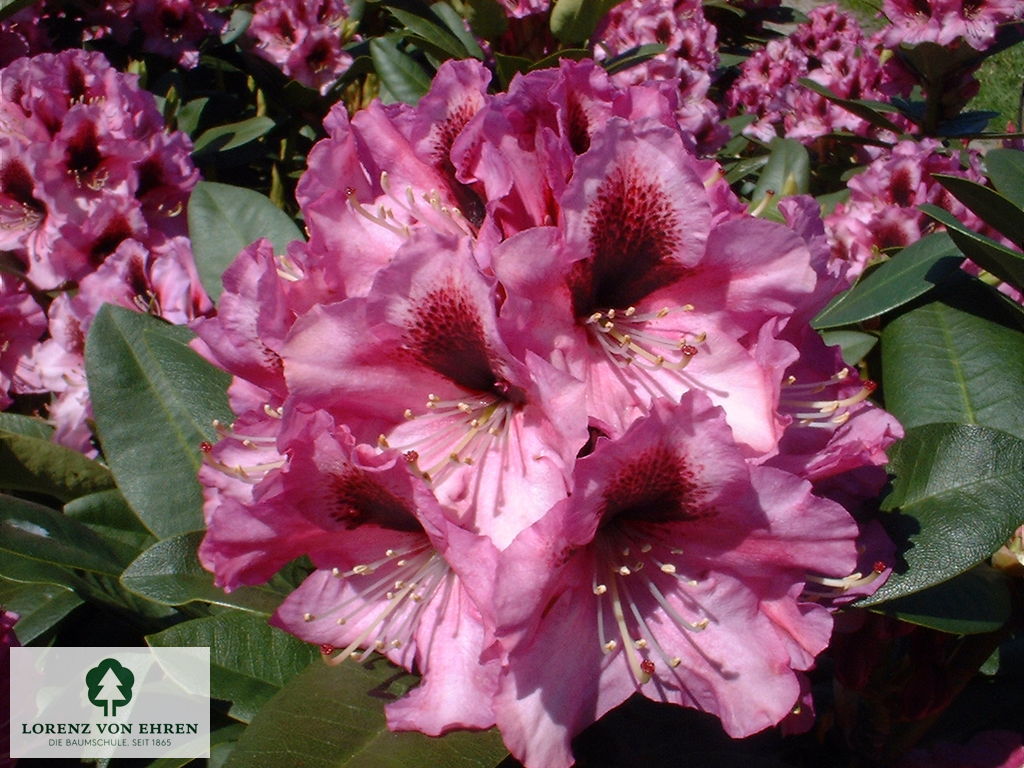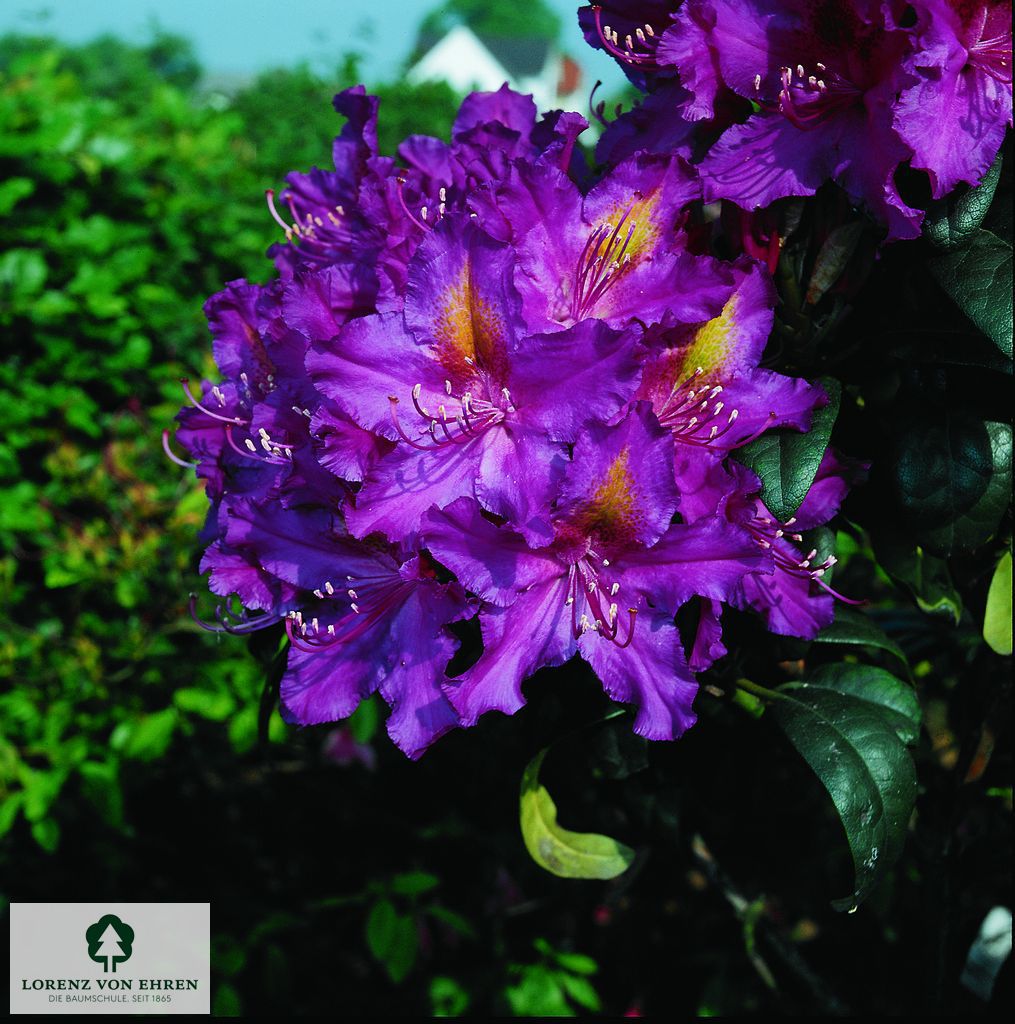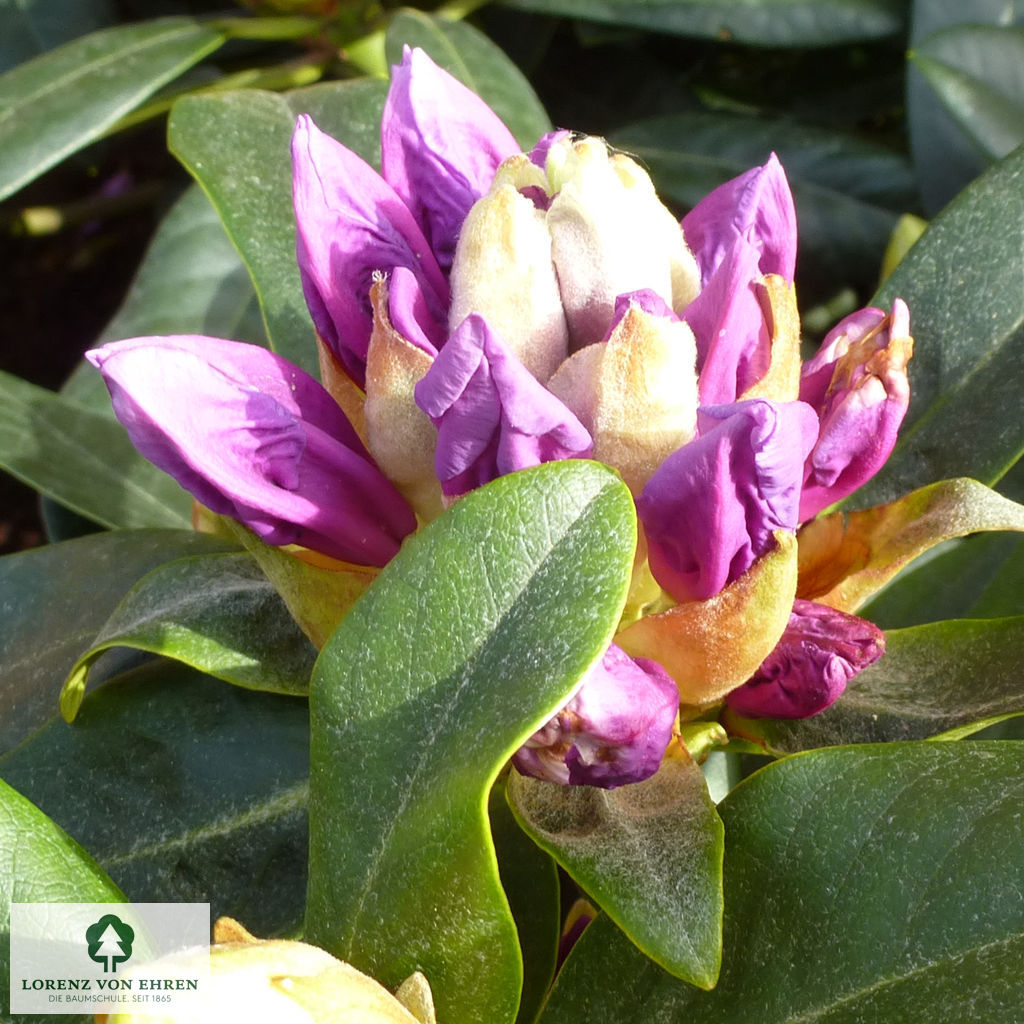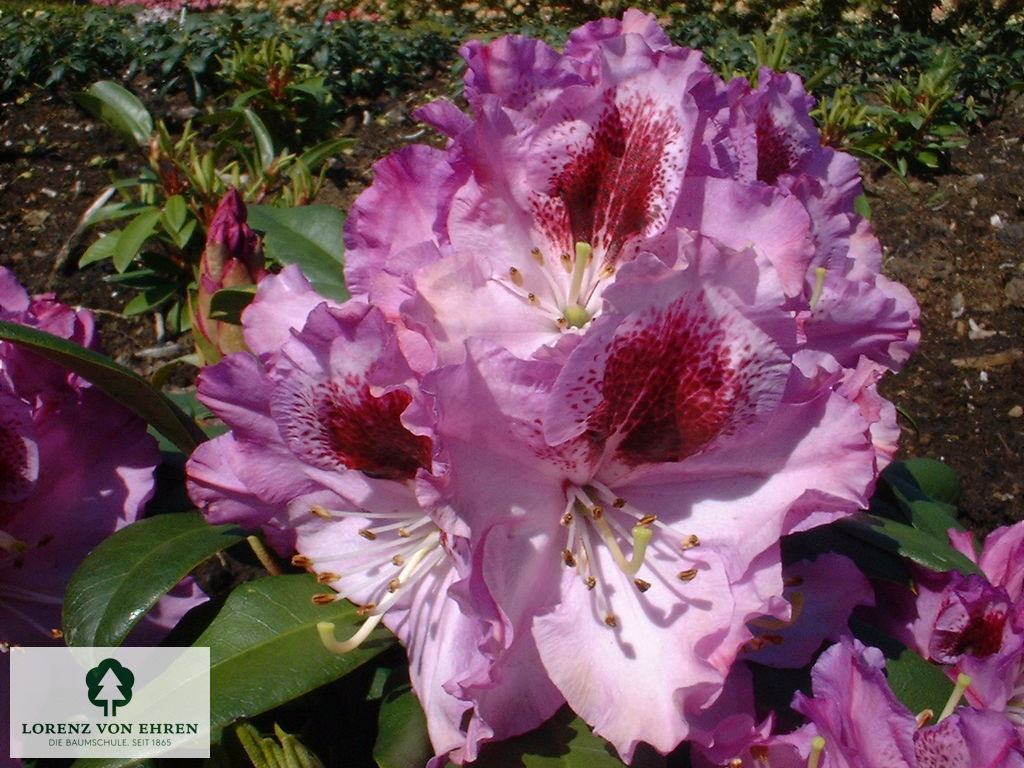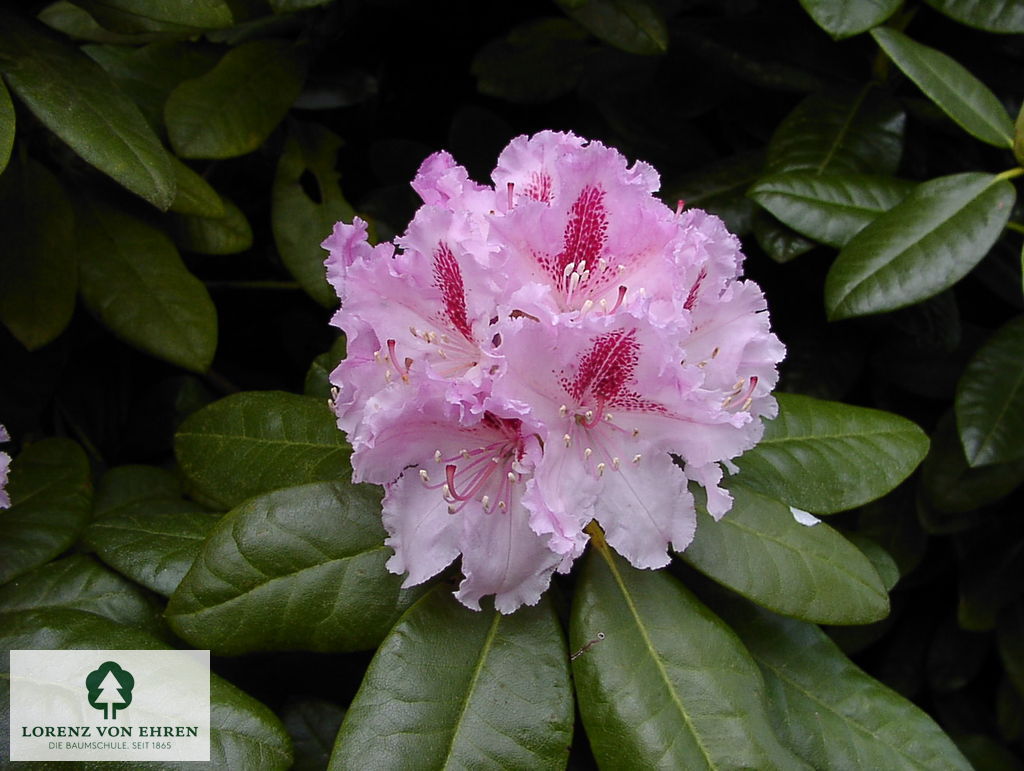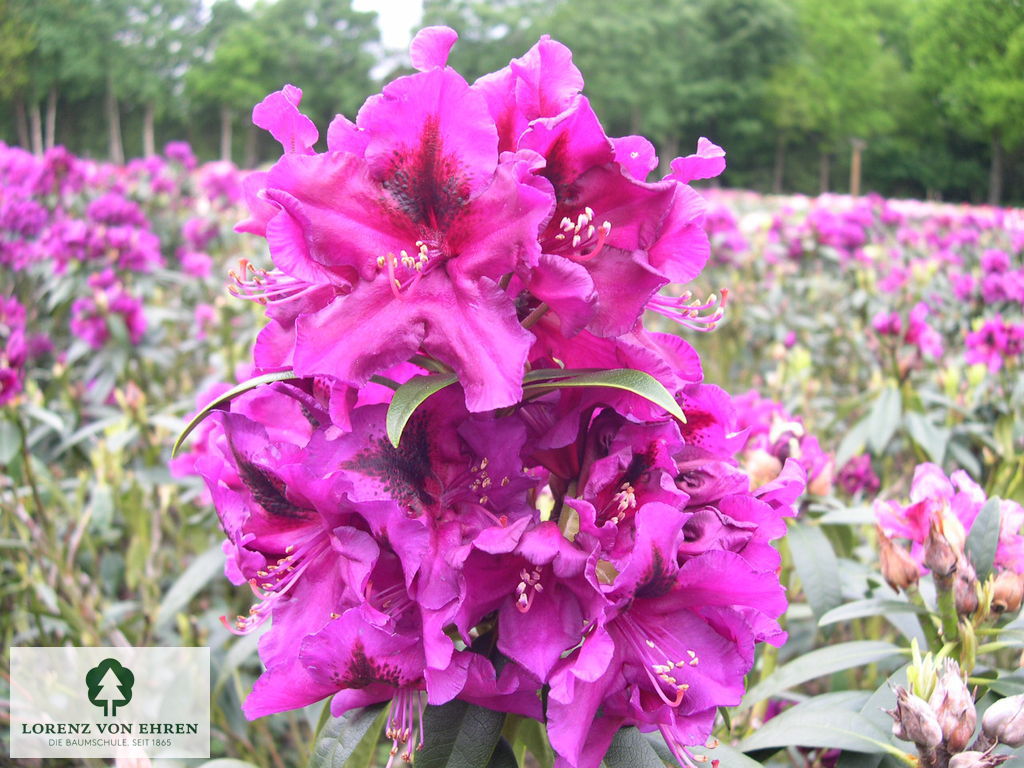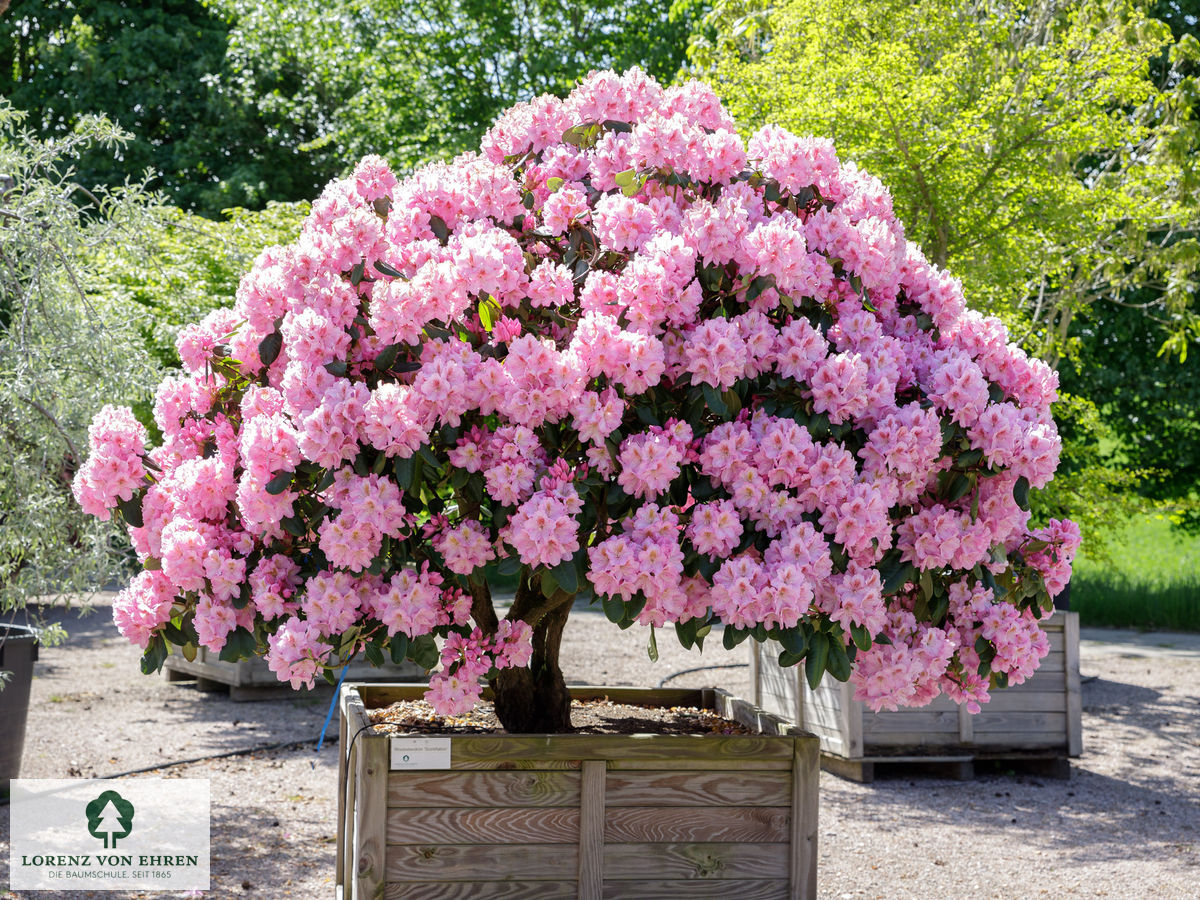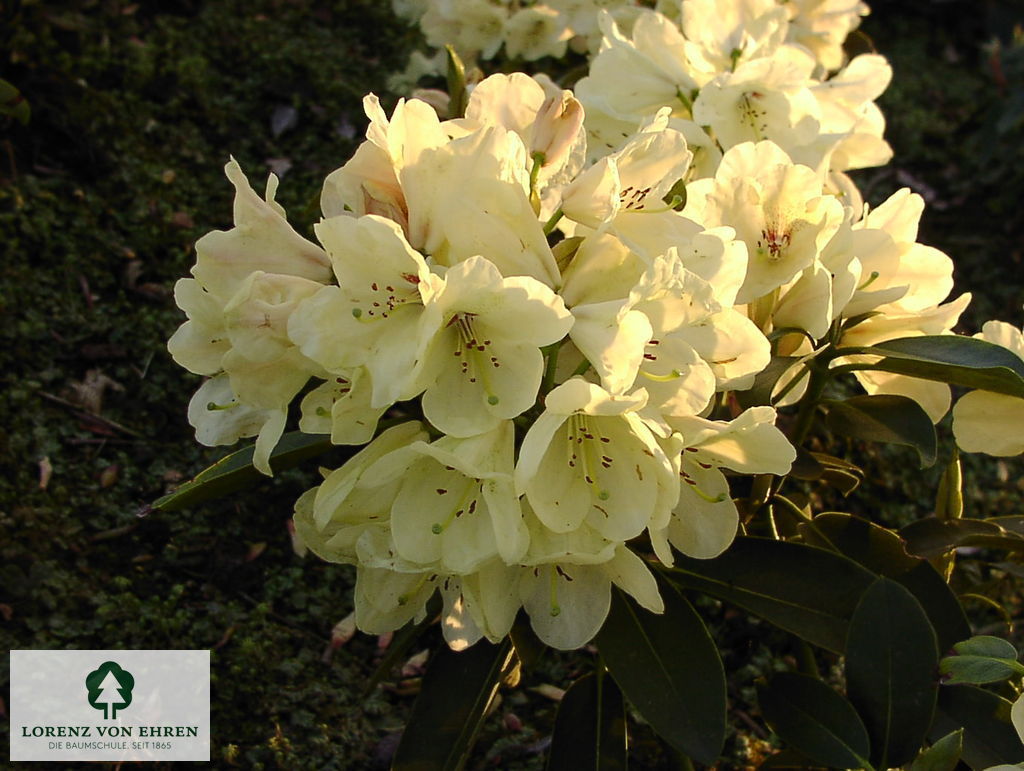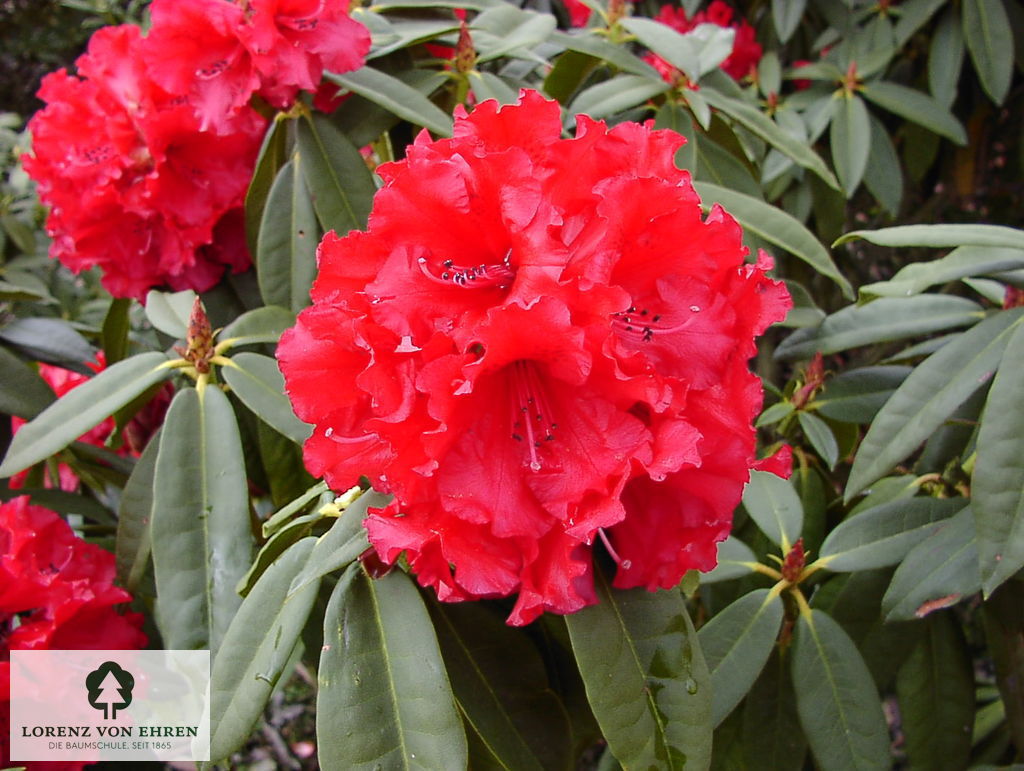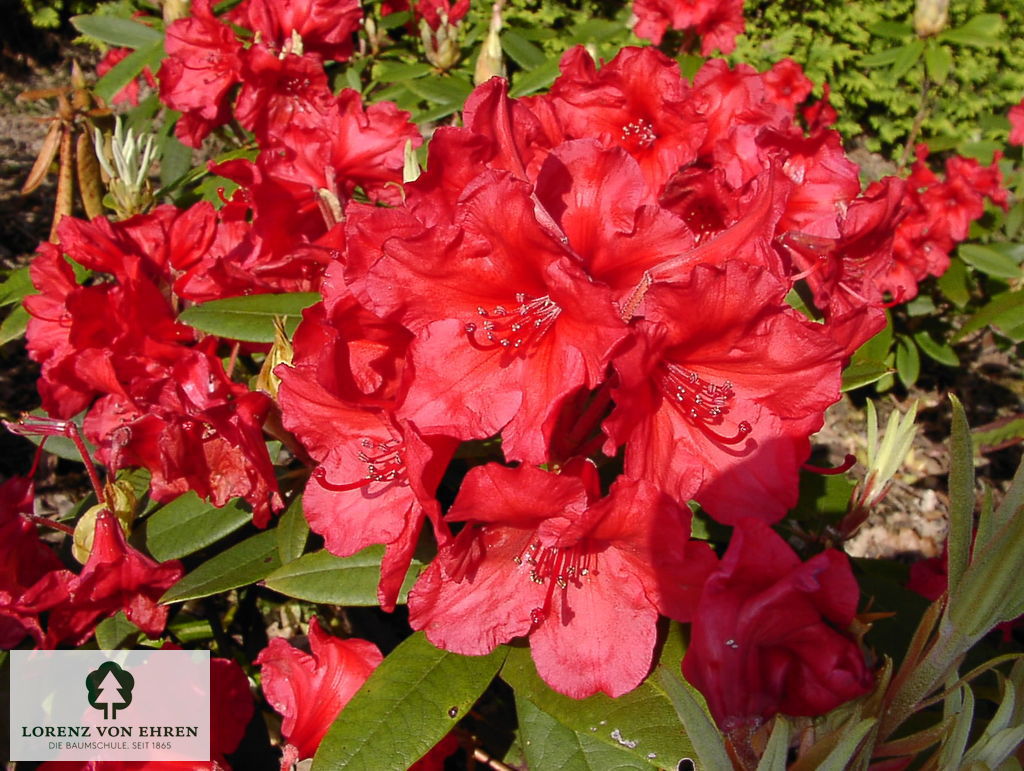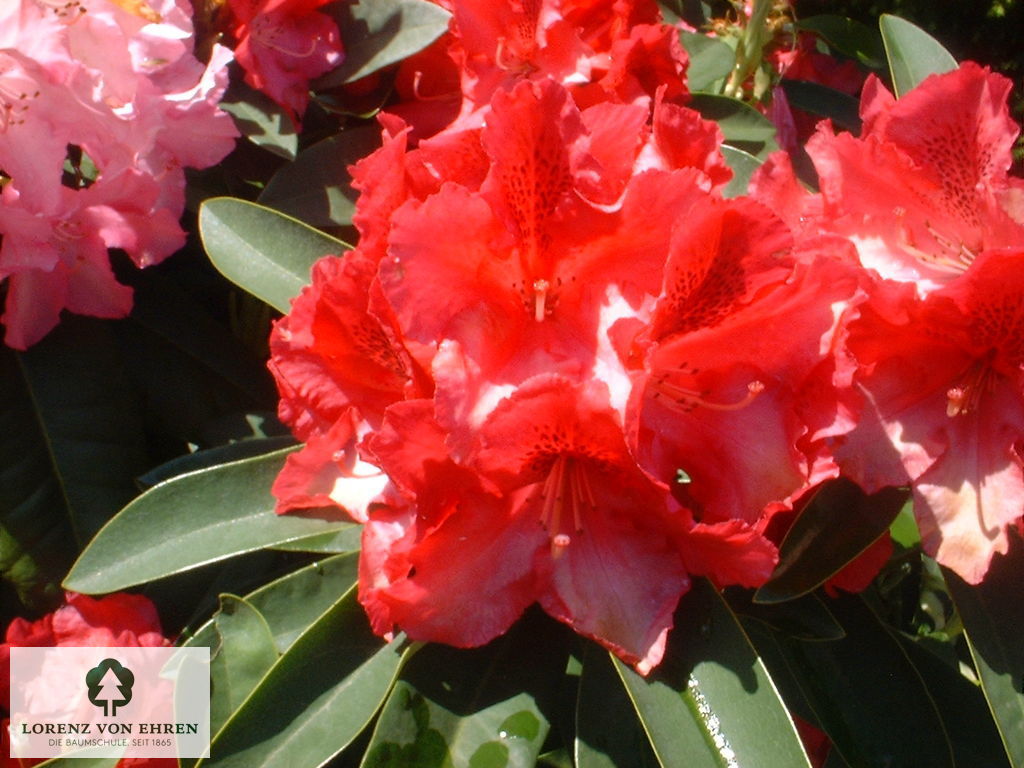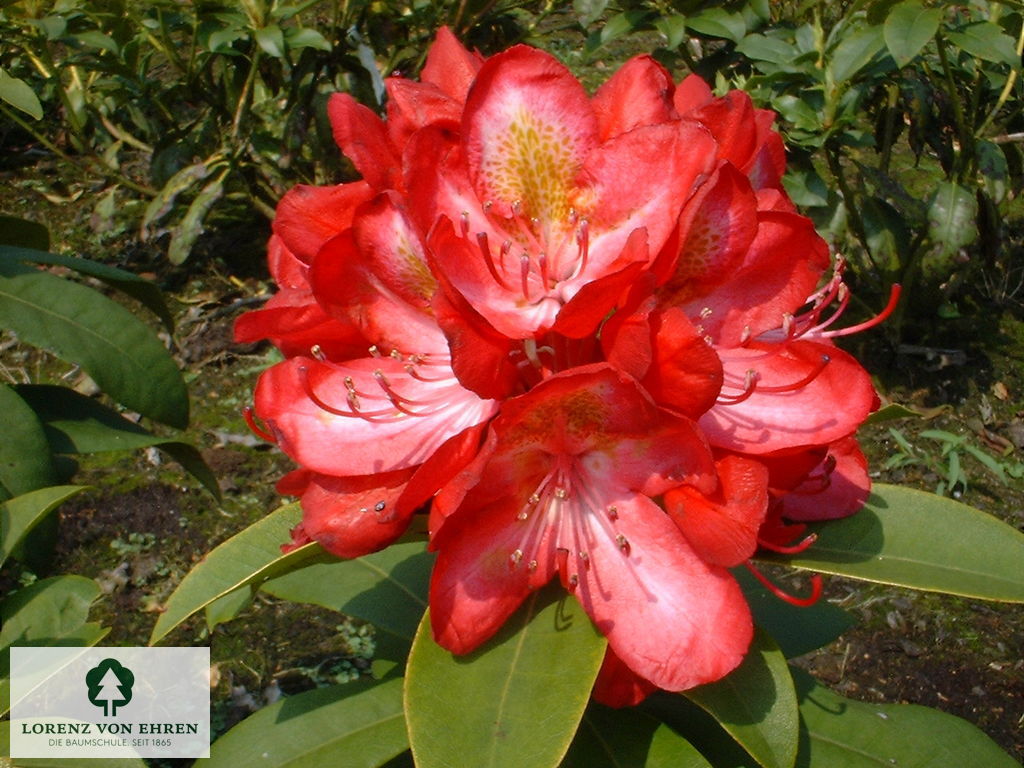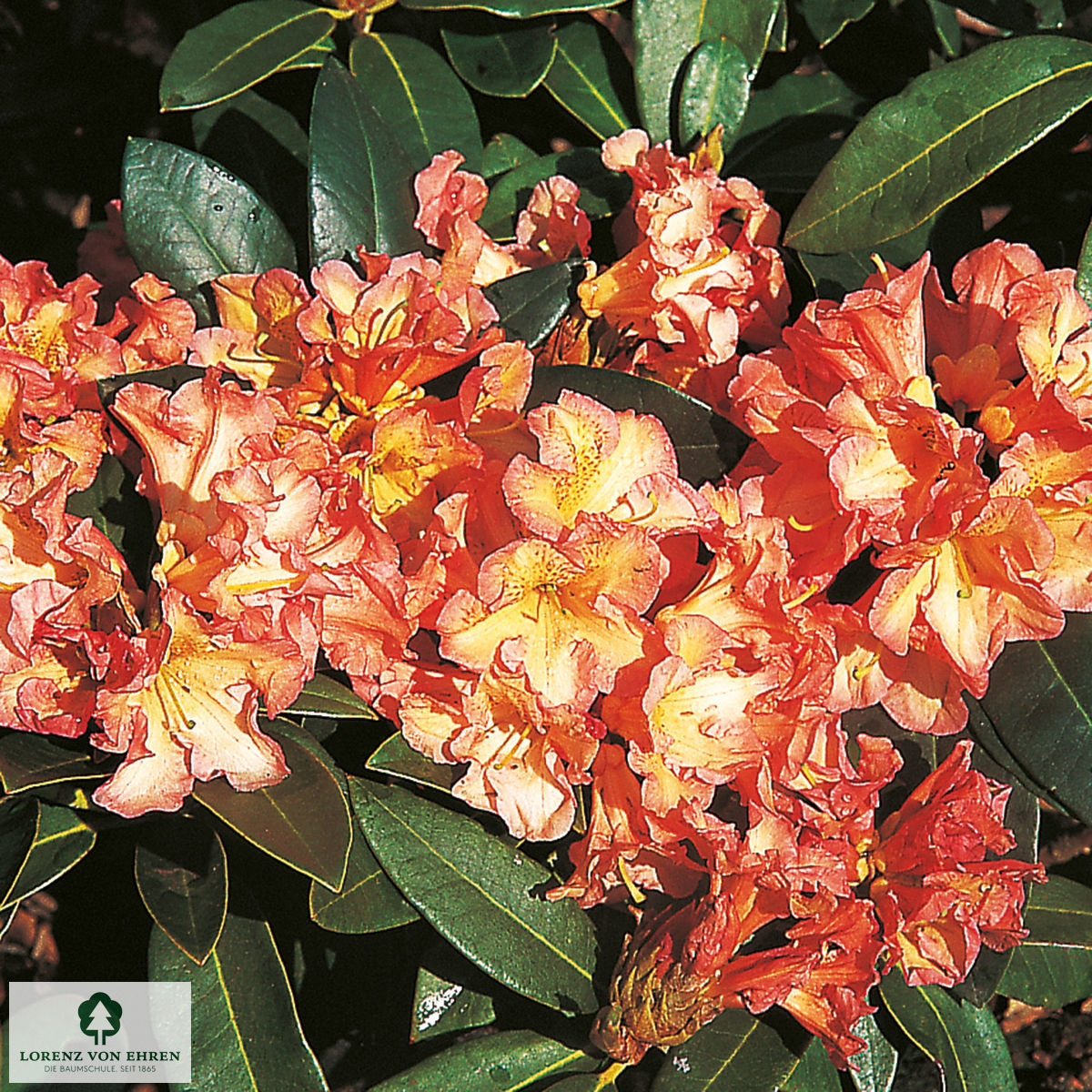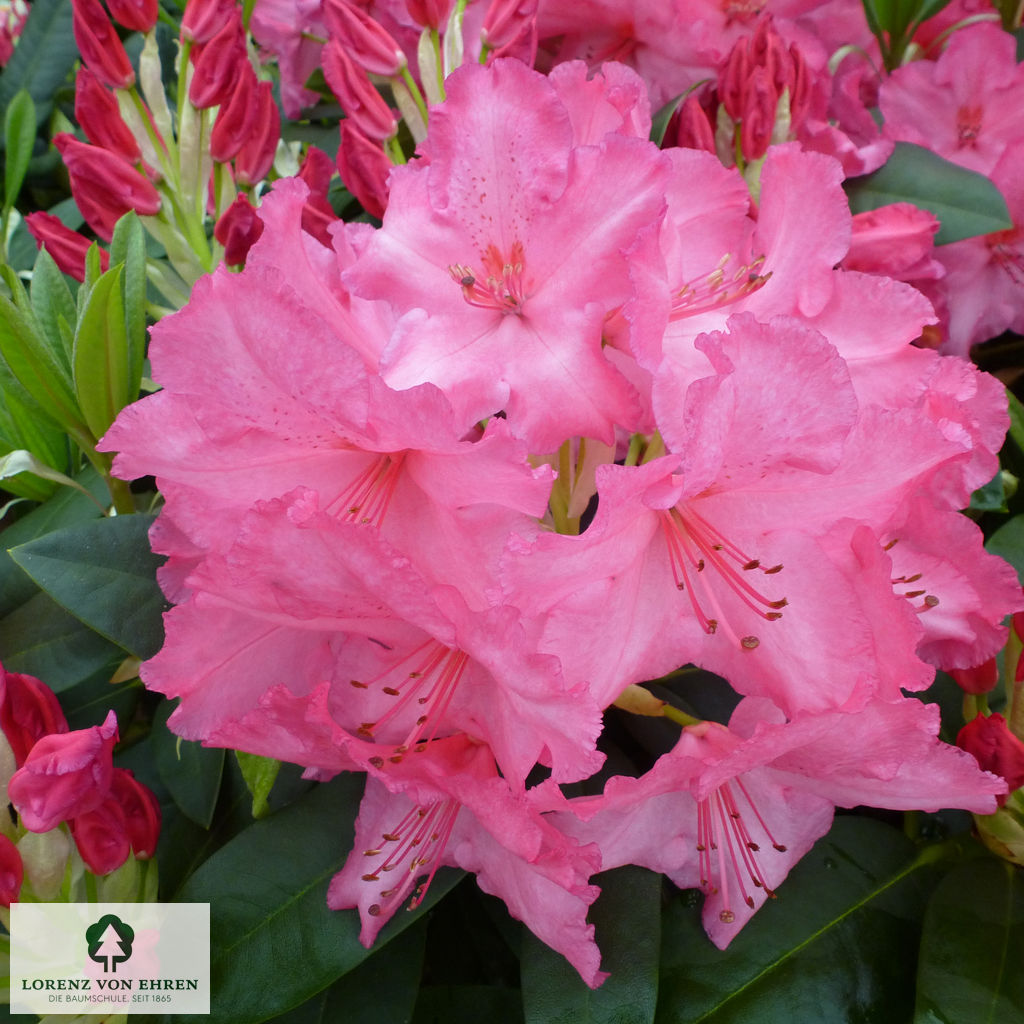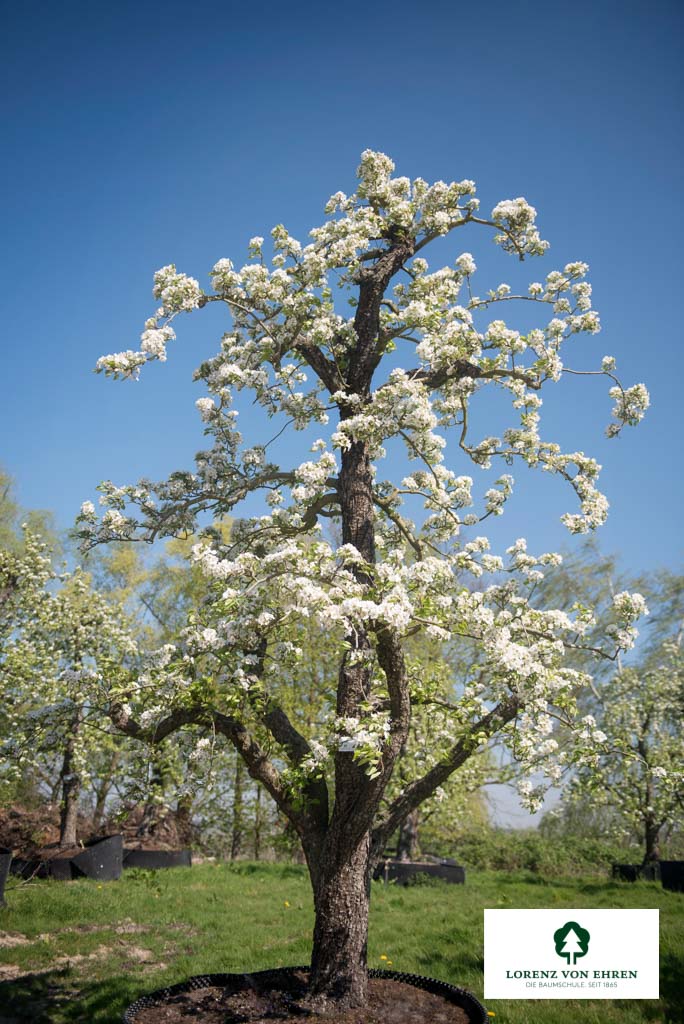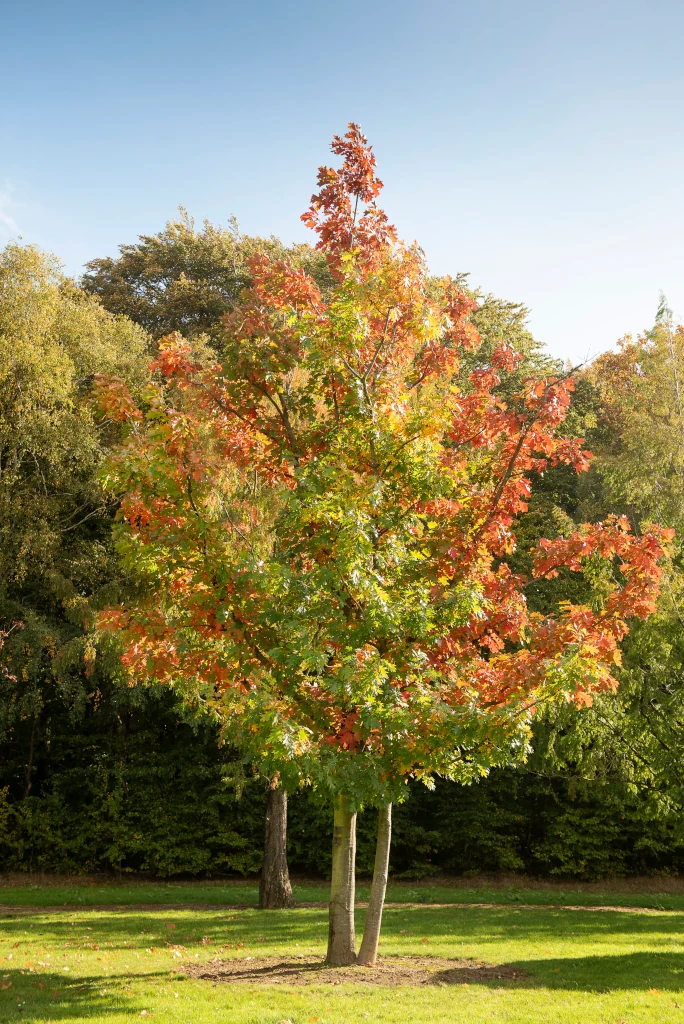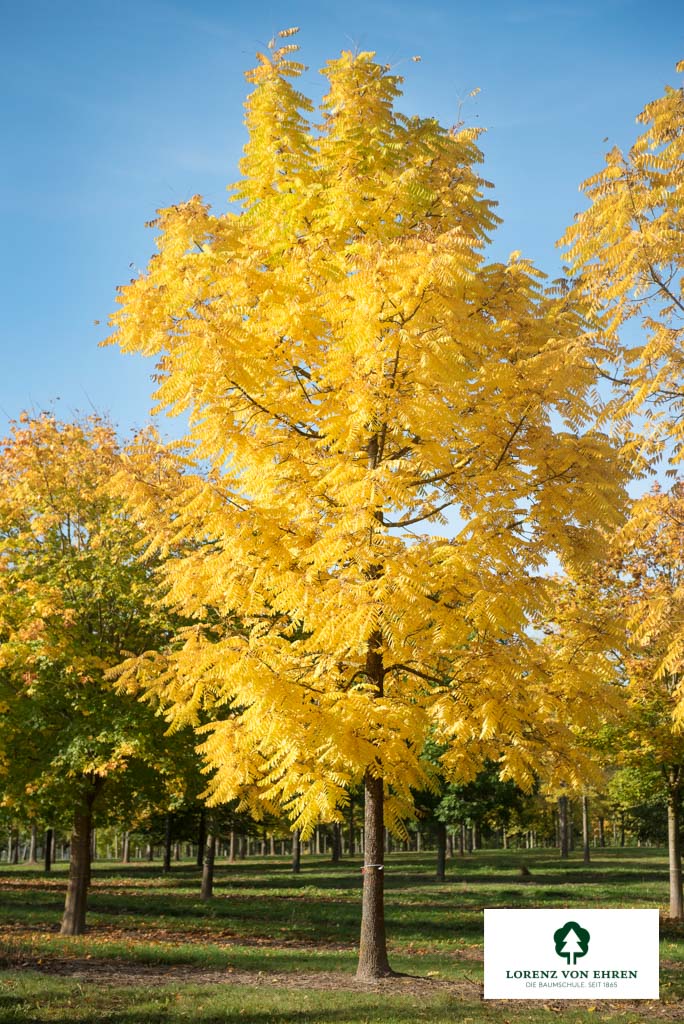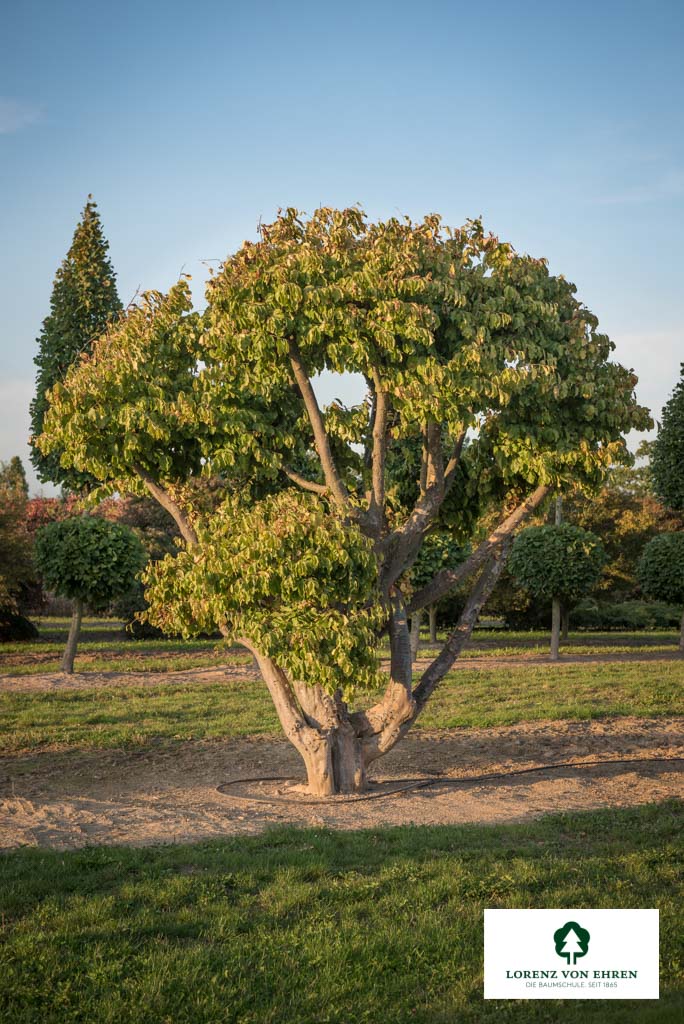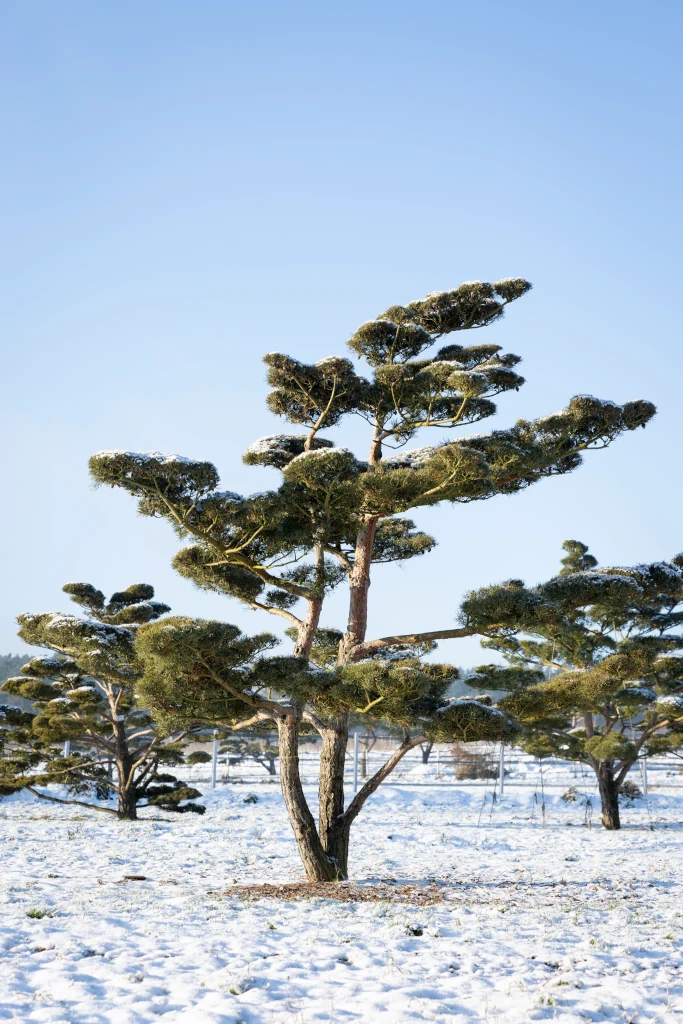Rhododendron
Ericaceae
Our Rhododendron
We know almost 1000 wild varieties of Rhododendrons on earth, most of them originating from Eastern Asia. Since the middle of the 19th century up to 30,000 varieties have been cultivated and registered – an infinite variety of types, shapes, foliages, colours and smells. Provided that the demands of these plants regarding soil and climate are fulfilled, Rhododendrons are quite easycare plants. The following classifications as well as colour and variety tables are drafted as a guideline to help find the Rhododendron you are looking for. The general demands of the plants with regard to the planting site can be found in front of the variety description.
Species and variety overview
Light and climate
Rhododendrons like an off-sun location, preferably in dappled shade under trees. They love moderate temperatures and a relatively high humidity. Good planting sites would be locations providing protection against dehydrating winds and cold winters. But Rhododendrons are not at all shade-loving plants! Locations providing dappled shade or sunny intervals are suitable. Too much shade would lead to a loose and squarrose habit of the plant as well as to reduced flowering and a shortened flowering time. If the air and the soil are humid enough, planting at sunny sites is also possible, e.g. near the seaside.
Soil
The finely branched root system of the Rhododendrons requires a loose soil, rich in humus and permeable to water. Encrusted soils are absolutely unsuitable. A lack of air and waterlogging can cause fungal diseases. Sandy, gravelly or clayey soils rich in humus are preferable. Additives rich in humus like peat dust, decayed foliage or other organic materials help to increase the quality of soils and substrates. If the Rododendron is planted on heavy, water-logged soil, it is recommended to dig the soil about 40-50 cm deep and to replace the substrate. For good water drainage a layer (10-15 cm) of course gravel is advised. Rhododendrons are acidophilic. The optimum pH level is 4.5-5.5. Soils with higher pH levels can be improved by adding acid humus or acid fertilizers on a regular basis. Inkarho®-Rhododendrons are suitable for soils with a high pH level (5.5-7.5).
Inkarho® - Rhododendron
The “INteressensgemeinschaft KAlktoleranter RHOdodendron” (= interest group for lime-tolerant Rhododendron) succeeded in cultivating lime-tolerant Rhododendrons. The assortment is grafted onto these special rootstocks and it is known as “Inkarho®-Rhododendron”. These plants also grow in difficult soils or at suboptimal sites. Even in soils that are rich in clay and have silt with high pH levels (from 5.5 to 7.0) these Rhododendrons develop strong roots and evolve as strong and healthy plants, rich in flowers. In loam or clay soils the loosening of the soil as well as adding organic materials is recommended.
Fertilizer
Rhododendrons have shallow roots which get their nutrients from the upper soil layers. We recommend the use of long-term as well as depot fertilizers, which should be steadily applied to the soil surface under the canopy of the plant. Depending on the duration of the fertilizer this should happen once or twice per year. Fertilization recommendations of the standard Rhododendron fertilizers should be respected. The quantity of the fertilizer depends on the size of the plant as well as the soil. Please consider that an organic mulch seeding would extract nutrients from the soil; the nitrogen would be fixed by microorganisms and would therefore not be available for the plant.
Evergreen (grafted) Rhododendron
Large-flower hybrids
This group contains rhododendron shrubs that are usually domed with initially compact habits, becoming loosely broad to tall with age. Their leaves are either slenderly elliptical or broadly ovoid, strong dark green or even black-green.
At the ends of the shoots, the leathery leaves are often densely packed ander the ball-shaped flower umbels. The varieties named are considered tried and tested cultivars with a reliably large number of flowers and sufficient to good frost hardiness.
Group I Robust varieties
Strong-growing, especially frost hardy cultivars from the standard assorment (as cold as -28°C); adaptable and robust; also for sunny areas with fresh to moist soil. Hedging elements and special varieties of large-flowering rhododendron hybrids available.
Group II Splendid rhododendrons – strong-growing varieties
Exclusive, conspicuous cultivars with many flowers exhibiting strong colours; upright and usually stronggrowing, though not so much as the robust varieties in group I; some are standards, some collector‘s items.
- Rhododendron Hybride 'Blue Peter'
- Rhododendron Hybride 'Catharine van Tol'
- Rhododendron Hybride 'Dr. H.C. Dresselhuys'
- Rhododendron Hybride 'Gomer Waterer'
- Rhododendron Hybride 'Humboldt'
- Rhododendron Hybride 'Jacksonii'
- Rhododendron Hybride 'Karl Naue'
- Rhododendron Hybride 'Lee's Dark Purple'
- Rhododendron Hybride 'Mad. Masson'
- Rhododendron Hybride 'Mogambo'
- Rhododendron Hybride 'Mrs P. den Ouden'
- Rhododendron Hybride 'Nova Zembla'
- Rhododendron Hybride 'Old Port'
- Rhododendron Hybride 'Simona'
Group III popular assortment - slow-growing varieties
Selected cultivars with extraordinary colours and early flowers before the varieties in groups I and II; usually slow-growing and smaller; require sunny areas protected from wind.
- Rhododendron Hybride 'Azurro'
- Rhododendron Hybride 'Berliner Liebe'
- Rhododendron Hybride 'Brasilia'
- Rhododendron Hybride 'Brigitte'
- Rhododendron Hybride 'Dagmar'
- Rhododendron Hybride 'Diadem'
- Rhododendron Hybride 'Erato'
- Rhododendron Hybride 'Furnivall's Daughter'
- Rhododendron Hybride 'Germania'
- Rhododendron Hybride 'Goldflimmer'
- Rhododendron Hybride 'Hachmanns Feuerschein'
- Rhododendron Hybride 'Kokardia'
- Rhododendron Hybride 'Libretto'
- Rhododendron Hybride 'Metallica'
- Rhododendron Hybride 'Pfauenauge'
- Rhododendron Hybride 'Progres'
- Rhododendron Hybride 'Purple Splendour'
- Rhododendron Hybride 'Rabatz'
- Rhododendron Hybride 'Scintillation'
- Rhododendron Hybride 'Stadt Westerstede'
- Rhododendron Hybride 'Taurus'
- Rhododendron Hybride 'Vulcan's Flame'
- Rhododendron Hybride 'Wilgen's Ruby'
Group IV special assortment
Slow-growing, compact new cultivars such as Insigne and Wardii hybrids, which have a conspicuous amount of flowers and extraordinary flower colours, not to mention healthy leaves and good winter hardiness.
Rhododendron hybrids 'Dufthecke'®
This lime-tolerant Rhododendron was cultivated especially for hedging purposes. The evergreen foliage is very dense, and due to its habit this plant provides a close sight protection throughout the year. Eye-catching are the purple petioles, the scent of the flowers is light.
- Rhododendron Hybriden 'Dufthecke' - white
Flower colour: cream white, margin light pink-violet
Flower mottling: greenish
Flowering time: beginning - end of May
Size in m: Height 1.50-2.0
Note: dark green leaves, very healthy
- Rhododendron Hybriden 'Dufthecke' - violet
Flower colour:light pink-violet
Flower mottling: greenish
Flowering time: end of May - end of June
Size in m: Height 1.50-2.0
Note: obovate,dark green leaves, very healthy
Yakushimanum hybrids - Compact Rhododendron
The Japanese rhododendron yakushimanum, a dense, squat, small shrub, was crossed with large-flower hybrids and cultivars of other evergreen species. This brought about a lower habit, more flowers, and improved winter hardiness.
Habit: Domed, dense small shrub, slow-growing; robust/adaptable varieties.
Flowers: Conical inflorescences; already with plentiful flowers when young.
Leaves: Thick-leathery, elongated, convex; shoots woolly white or yellowish grey tomentose; then dull green on top, grey to brown tomentose anderneath.
Demands: Sun-light shade; tolerates warmth; usually frost hardy.
Soil: Well drained, sandy-humic substrates; acidic-neutral, somewhat tolerant of chalk.
Group I
- Rhododendron yakushimanum 'Anuschka'
- Rhododendron yakushimanum 'Ballkönigin'
- Rhododendron yakushimanum 'Blurettia'
- Rhododendron yakushimanum 'Bohlken's Lupinenberg'
- Rhododendron yakushimanum 'Flava'
- Rhododendron yakushimanum 'Kalinka'
- Rhododendron yakushimanum 'Morgenrot'
- Rhododendron yakushimanum 'Percy Wiseman'
- Rhododendron yakushimanum 'Polaris'
- Rhododendron yakushimanum 'Schneekrone'
- Rhododendron yakushimanum 'Silberwolke'
- Rhododendron yakushimanum 'Tatjana'
Group III
- Rhododendron yakushimanum 'Astrid'
- Rhododendron yakushimanum 'Colibri'
- Rhododendron yakushimanum 'Edelweiss'
- Rhododendron yakushimanum 'Goldprinz'
- Rhododendron yakushimanum 'Koichiro Wada'
- Rhododendron yakushimanum 'Lucinda'
- Rhododendron yakushimanum 'Nicoletta'
- Rhododendron yakushimanum 'Silver Lady'
Williamsianum hybrids - Rhododendron
The hybrids were formed from cross between the small-shrub Rhododendron williamsianum with large-flower garden hybrids.
Habit: Usually small shrubs, domes or round; slow-growing.
Leaves: Shimmering brown-red or bronze-green shoots, then pale green; round-oval.
Demands: : Light shade to semi-shade, possible in the sun in regularly coolhumid areas, otherwise flowers bleach out greatly or lose their firmness; moderately frost hardy; fresh to moist, sensitive to heat and drought; needs wind protection.
Soil: Tolerates chalk moderately on humic soil.
- Rhododendron williamsianum 'August Lamken'
- Rhododendron williamsianum 'Gartendirektor Glocker'
- Rhododendron williamsianum 'Gartendirektor Rieger'
- Rhododendron williamsianum 'Irmelies'
- Rhododendron williamsianum 'Jackwill'
- Rhododendron williamsianum 'Lissabon'
- Rhododendron williamsianum 'Rodrigo'
- Rhododendron williamsianum 'Rothenburg'
- Rhododendron williamsianum 'Stadt Essen'
- Rhododendron williamsianum 'Tromba'
- Rhododendron williamsianum 'Vater Böhlje'
Repens hybrids – Red dwarf rhododendrons
These hybrids were cultivated by crossing slim Rhododendrons williamsianum with large flowered hybrids.
Habit: Cushion dwarf shrubs, prostrate, slow-growing.
Flowers: Like bells, usually bright red hues, shiny; among the earliest flowering types.
Leaves: Medium-sized, elliptical, dark to black-green.
Demands: Sun or light shade, losing its squat habit in deep shade; cool-humid, suffers from heat and drought, moderately frost hardy; needs protection.
Soil: Moderately lime-tolerant on soils rich in humus.
Wild varieties and their hybrids
The evergreen wild varieties and their hybrids are an effective and necessary alternative to the colourful cultivars. Thanks to their different flowering periods and their unusual habits and foliage, they complement the hybrids in many respects and create an exciting contrast.
Group I
- Rhododendron augustinii 'Saphirblau'
- Rhododendron calophytum
- Rhododendron carolinianum 'P.J.M. Elite'
- Rhododendron carolinianum 'P.J. Mezitt'
- Rhododendron impeditum
- Rhododendron impeditum 'Azurika'
- Rhododendron impeditum 'Blaumeise'
- Rhododendron impeditum 'Blue Tit'
- Rhododendron impeditum 'Blue Tit Magor'
- Rhododendron impeditum 'Blue Wonder'
- Rhododendron impeditum 'Luisella'
- Rhododendron impeditum 'Moerheim'
- Rhododendron impeditum 'Ramapo'
- Rhododendron 'Praecox'
- Rhododendron russatum 'Azurwolke'
- Rhododendron russatum 'Enziana'
- Rhododendron russatum 'Gletschernacht'
- Rhododendron russatum 'Lauretta'

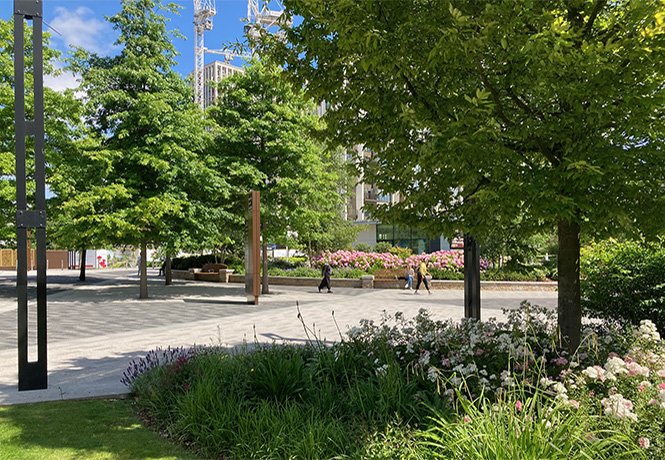
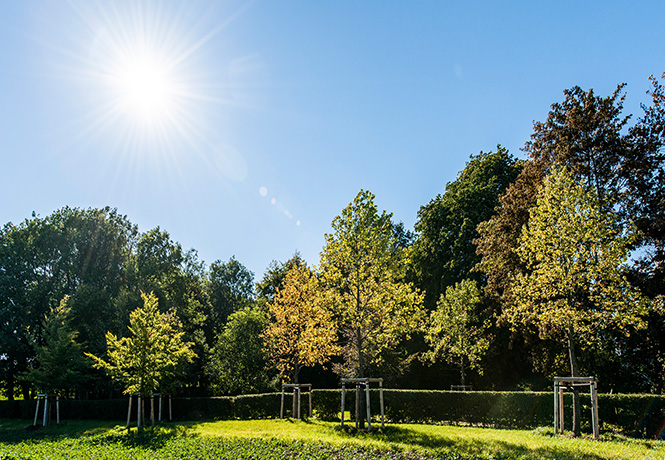
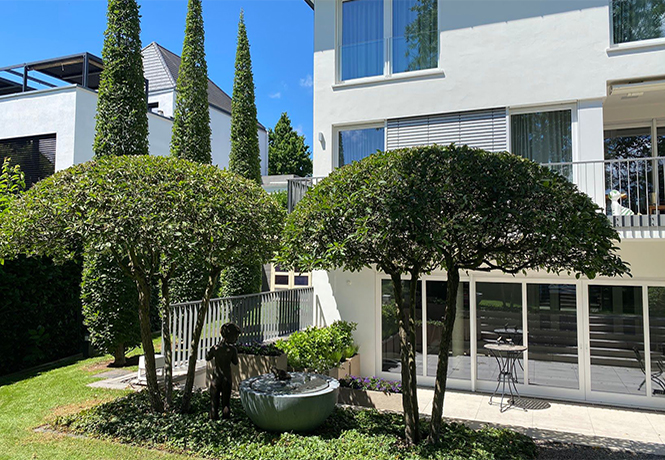
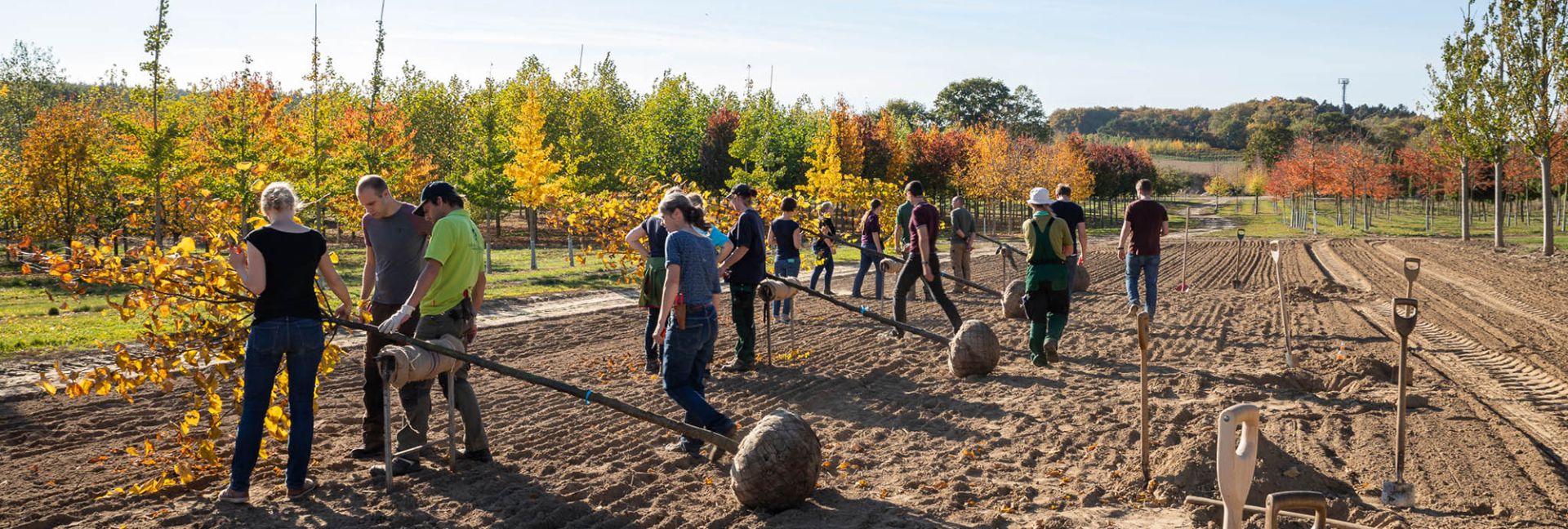
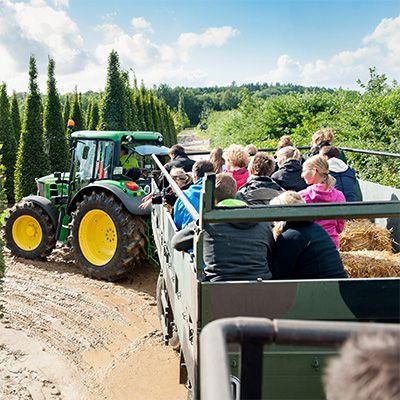
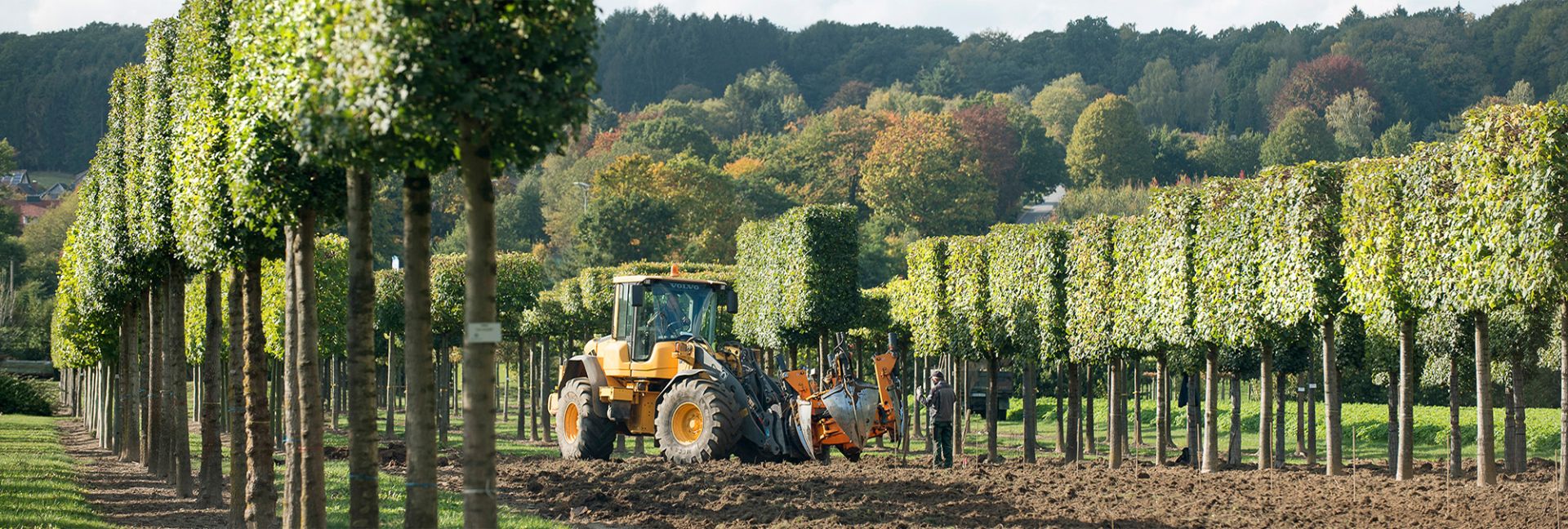
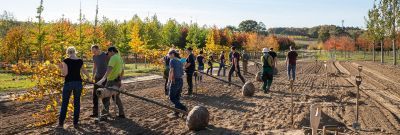
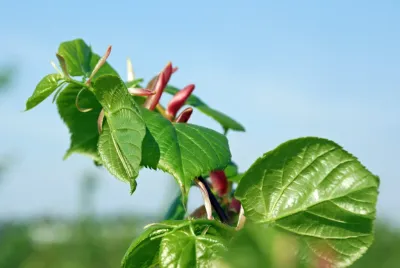
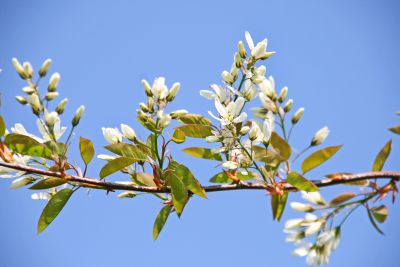
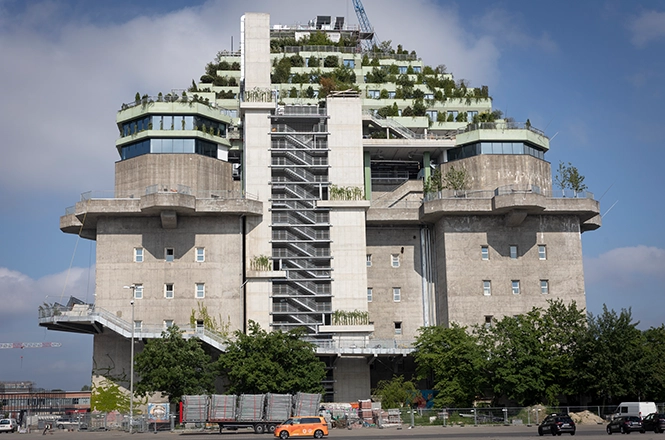
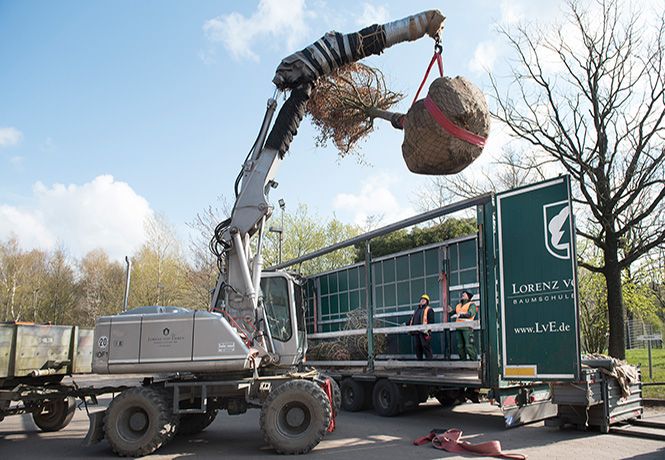
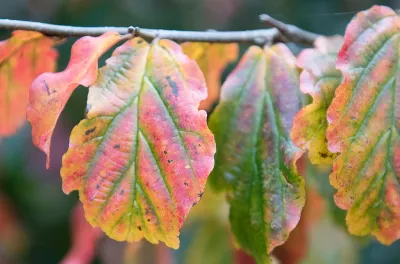
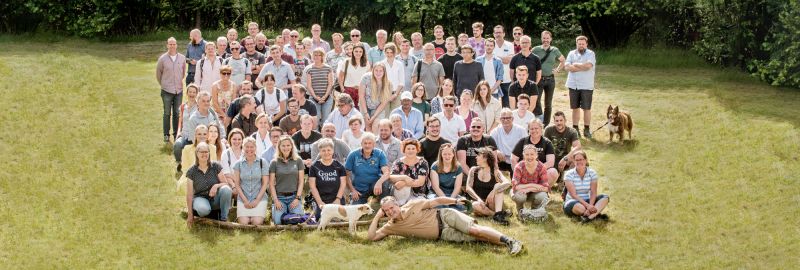
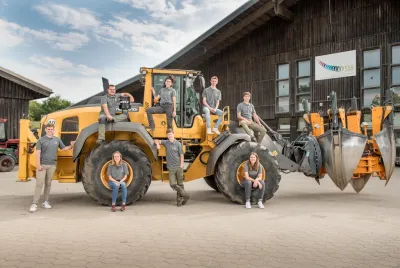
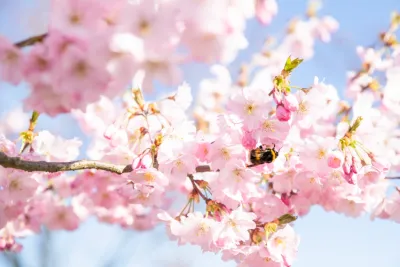
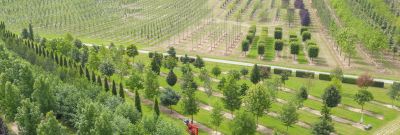
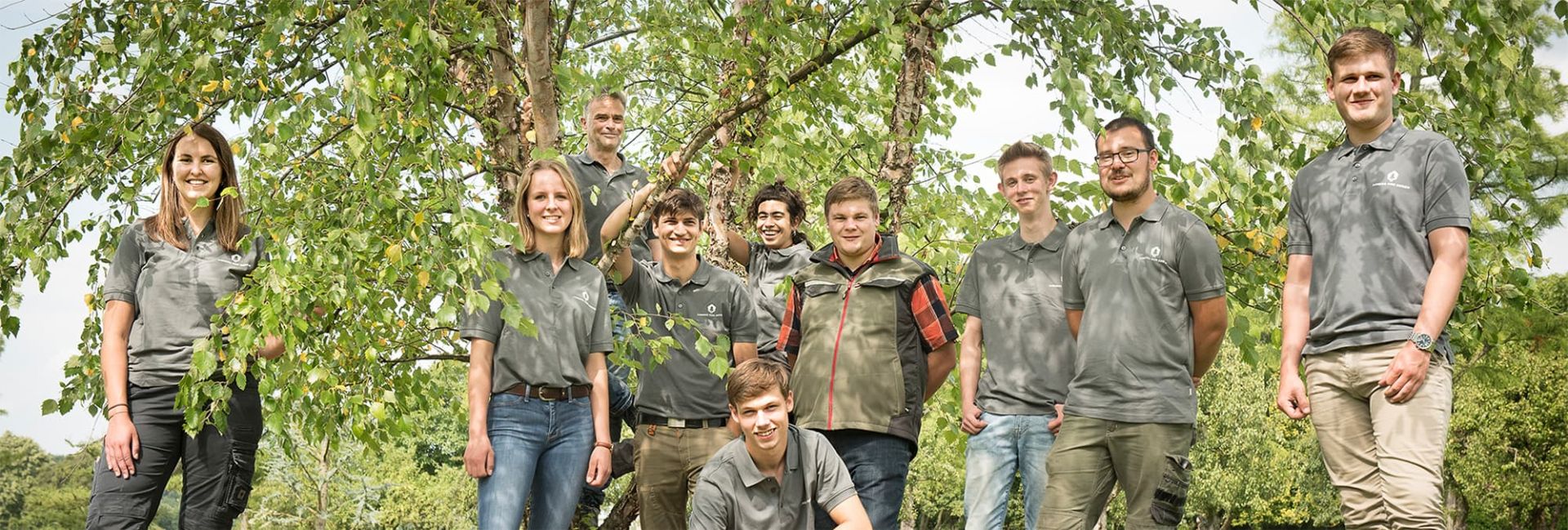
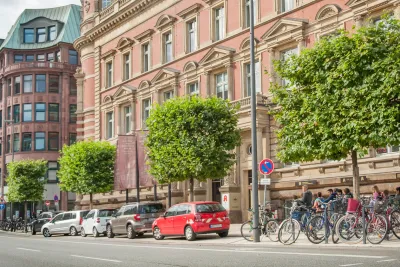
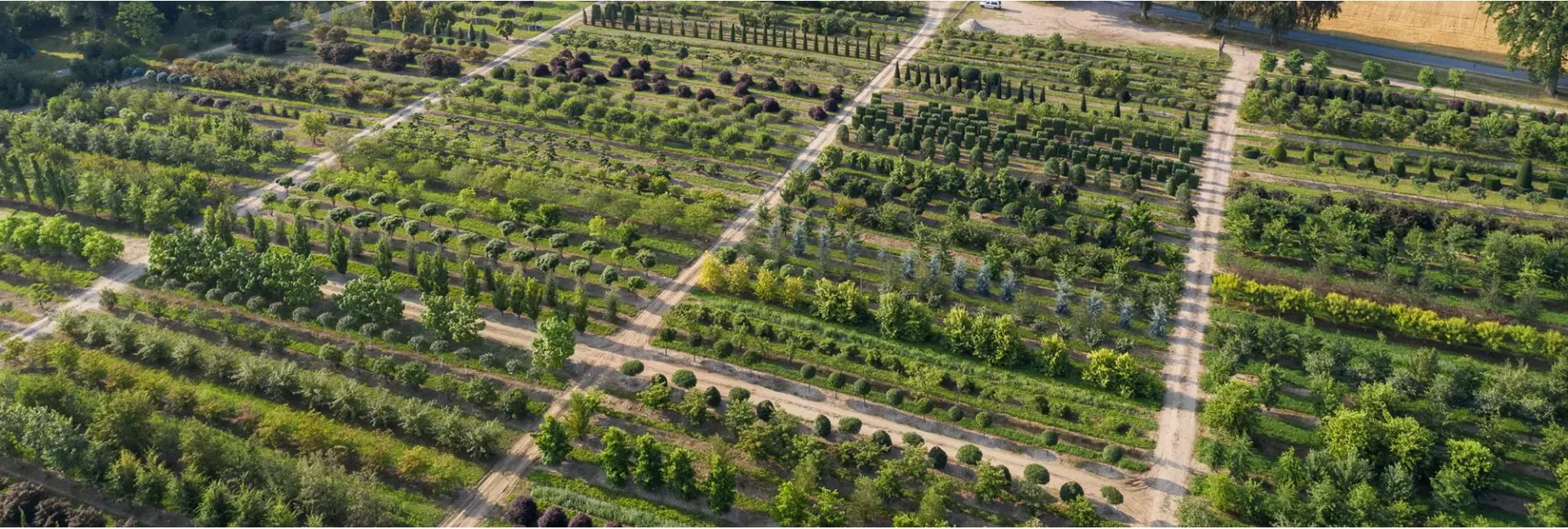
_400x400.webp)
